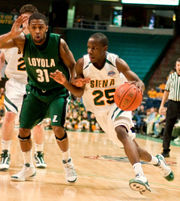Albany, New York
| Albany | |||
| City | |||
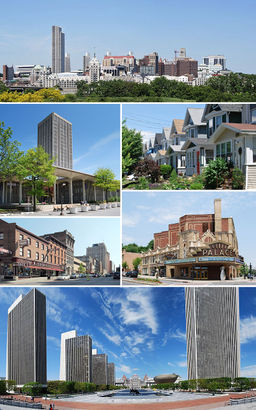 Clockwise from top: Albany skyline from Rensselaer; middle-class housing in the Helderberg neighborhood; Palace Theatre; Empire State Plaza from the Cultural Education Center; North Pearl Street at Columbia Street; and the State Quad at SUNY Albany.
|
|||
|
|||
| Name origin: Named for the English Duke of Albany, whose title comes from the Gaelic name for Scotland: Alba | |||
| Motto: Assiduity[Note 1] | |||
| Country | |||
|---|---|---|---|
| State | |||
| Region | Capital District | ||
| County | Albany | ||
| Landmark | Empire State Plaza | ||
| River | Hudson | ||
| Coordinates | |||
| Highest point | Unnamed hill | ||
| - elevation | 324 ft (99 m) | ||
| - coordinates | |||
| Lowest point | Hudson River | ||
| - elevation | 0 ft (0 m) | ||
| Area | 21.8 sq mi (56 km²) | ||
| - land | 21.4 sq mi (55 km²) | ||
| - water | 0.4 sq mi (1 km²) | ||
| - metro | 6,570 sq mi (17,016 km²) | ||
| Population | 93,539 (2008 estimate) | ||
| - metro | 857,592 | ||
| Density | 5,488.1 / sq mi (2,119 / km²) | ||
| Settled | 1614 | ||
| Incorporation as city | 1686 | ||
| Government | Albany City Hall | ||
| - location | 24 Eagle Street | ||
| - coordinates | |||
| Mayor | Gerald Jennings (D)
Common Council
President:
Carolyn McLaughlin (D) W1: Dominick Calsolaro (D) W2: Lester Freeman (D) W3: Ronald E. Bailey (D) W4: Barbara Smith (D) W5: Jackie Jenkins-Cox (D) W6: Richard Conti (D) W7: Catherine Fahey (D) W8: John Rosenzweig (D) W9: James P. Sano (D) W10: Leah Golby (D) W11: Anton Konev (D) W12: Michael O'Brien (D) W13: Daniel F. Herring (D) W14: Joseph Igoe (D) W15: Frank Commisso, Jr. (D) |
||
| Timezone | Eastern (EST) (UTC-5) | ||
| - summer (DST) | EDT (UTC-4) | ||
| ZIP Code | 12201-12, 12214, 12220, 12222-32 | ||
| Area code | 518 | ||
| FIPS code | 36-01000 | ||
| GNIS feature ID | 0977310 | ||
| Demonym | Albanian | ||
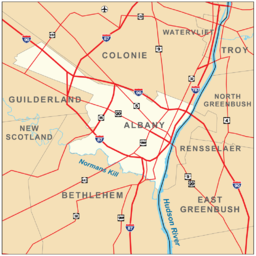 Boundaries of and major thoroughfares through Albany
|
|||
 Location of Albany within Albany County and New York State
|
|||
| Wikimedia Commons: Albany, New York | |||
| Website: albanyny.org/ | |||
Albany (pronounced /ˈɔːlbəniː/ AWL-bə-nee) is the capital city of the US state of New York, the seat of Albany County, and the central city of New York's Capital District. At roughly 150 miles (240 km) north of New York City, Albany sits on the west bank of the Hudson River, about 10 miles (16 km) south of its confluence of the Mohawk River. The city had an estimated population of 93,539 as of 2008; the population of the greater metropolitan area was estimated at 857,592 as of 2009. Albany has close ties with the nearby cities of Troy, Schenectady, and Saratoga Springs, forming a region called the Capital District. The bulk of this area is made up of the Albany-Schenectady-Troy Metropolitan Statistical Area (MSA); this MSA is the fourth largest urban area in New York and the 56th largest MSA in the country.[2]
Albany was permanently settled in 1614 and officially chartered as a city in 1686. It became the capital of New York in 1797. It is one of the oldest surviving settlements from the original thirteen colonies, and the longest continuously chartered city in the United States. Modern Albany was founded as the Dutch trading posts of Fort Nassau in 1614 and Fort Orange in 1623; the fur trade brought in a population that settled around Fort Orange and founded a village called Beverwijck. The English took over and renamed the town Albany in 1664, in honor of the English Duke of Albany. The city was officially chartered in 1686 with the issuance of the Dongan Charter, the oldest effective city charter in the nation and possibly the longest-running instrument of municipal government in the Western Hemisphere.
In the late 18th century and most of the 19th century, Albany was a center of transportation. It is located on the north end of the navigable Hudson River, is the eastern terminus of the Erie Canal, and is home to some of the earliest railroad systems in the world. Albany's main exports at the time were beer, lumber, published works, and ironworks. Beginning in 1810, Albany was one of the ten most populous cities in the nation, a distinction that it held until the 1860 census. In the 20th century, the city opened one of the first commercial airports in the world, the precursor of today's Albany International Airport. The 1920s saw the rise of a powerful political machine controlled by the Democratic Party. The city's skyline changed in the 1960s with the construction of the Empire State Plaza and the uptown campus of SUNY Albany,[Note 2] mainly under the direction of Governor Nelson Rockefeller. While Albany experienced a decline in its population due to urban sprawl, many of its historic neighborhoods were saved from destruction through the policies of Mayor Erastus Corning 2nd, the longest-serving mayor of any city in the United States. More recently, the city has experienced growth in the high-tech industry, with great strides in the nanotechnology sector.
Albany has been a center of higher education for over a century, with much of the remainder of its economy dependent on state government and health care services. The city has experienced a rebound from the urban decline of the 1970s and 1980s, with noticeable development happening in the city's downtown and midtown neighborhoods. Albany is known for its extensive history, culture, architecture, and institutions of higher education. The city is home to the mother churches of two Christian dioceses as well as the oldest Christian congregation in upstate New York. Albany is a two-time All-America City Award winner (1991 and 2009).[3]
Contents |
History
Colonial times to 1800
Albany is one of the oldest surviving European settlements from the original thirteen colonies[5] and the longest continuously chartered city in the United States.[Note 3] Albany was originally inhabited by Algonquian Indian tribes and was given different names by the various peoples. The Mohicans called it Pempotowwuthut-Muhhcanneuw, meaning "the fireplace of the Mohican nation",[8] while the Iroquois called it Sche-negh-ta-da, or "through the pine woods".[9][Note 4] Albany's first European structure was a primitive fort on Castle Island built by French traders in 1540. It was destroyed by flooding soon after construction.[11]
Permanent European claims began when Englishman Henry Hudson, exploring for the Dutch East India Company on the Half Moon (Dutch: Halve Maen), reached the area in 1609, claiming it for the United Netherlands.[12] In 1614, Hendrick Christiaensen rebuilt the French fort as Fort Nassau, the first Dutch fur trading post in present-day Albany.[13] Commencement of the fur trade provoked hostility from the French colony in Canada and amongst the natives, all of whom vied to control the trade. In 1618, a flood ruined the fort on Castle Island, but it was rebuilt in 1624 as Fort Orange.[14] Both forts were named in honor of the royal Dutch House of Orange-Nassau.[15] Fort Orange and the surrounding area were incorporated as the village of Beverwijck (English: Beaver District) in 1652.[16][17]
When New Netherland was captured by the English in 1664, the name Beverwijck was changed to Albany, in honor of the Duke of Albany (later James II of England[Note 5]).[18] Duke of Albany was a Scottish title given since 1398, generally to a younger son of the King of Scots.[19] The name is ultimately derived from Alba, the Gaelic name for Scotland.[20] The Dutch briefly regained Albany in August 1673 and renamed the city Willemstadt; the English took permanent possession with the Treaty of Westminster (1674).[21] On November 1, 1683, the Province of New York was split into counties, with Albany County being the largest. At that time the county included all of present New York State north of Dutchess and Ulster Counties in addition to present-day Bennington County, Vermont, theoretically stretching west to the Pacific Ocean;[22][23] the city of Albany became the county seat.[24] Albany was formally chartered as a municipality by provincial Governor Thomas Dongan on July 22, 1686. The Dongan Charter was virtually identical in content to the charter awarded to the city of New York three months earlier.[25] At this point, Beverwijck had a population of about 500.[26]
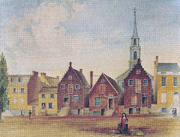
In 1754, representatives of seven British North American colonies met in the Stadt Huys, Albany's city hall,[Note 6] for the Albany Congress; Benjamin Franklin of Pennsylvania presented the Albany Plan of Union there, which was the first formal proposal to unite the colonies.[27] Although it was never adopted by Parliament, it was an important precursor to the United States Constitution.[28][Note 7] The same year, the French and Indian War, the fourth in a series of wars dating back to 1689, began; it ended in 1763 with French defeat, resolving a situation that had been a constant threat to Albany and held back its growth.[29] In 1776, with the colonies in the midst of the Revolutionary War, Albany native Philip Livingston signed the Declaration of Independence at Independence Hall in Philadelphia.[30]
During and after the Revolutionary War, Albany County saw a great increase in the number of real estate transactions. After Horatio Gates' win over John Burgoyne at Saratoga in 1777, the upper Hudson Valley was generally at peace as the war raged on elsewhere. Prosperity was soon seen all over upstate New York. Migrants from Vermont and Connecticut began flowing in, noting the advantages of living on the Hudson and trading at Albany, while being only a few days' sail from New York City.[31] Albany reported a population of 3,498 in the first national census in 1790, an increase of almost 700% since its chartering.[26] In 1797, the state capital of New York was moved permanently to Albany. From statehood to this date, the Legislature had frequently moved the state capital between Albany, Kingston, Poughkeepsie, and the city of New York.[32] Albany is the second oldest state capital in the United States.[33]
1800 to 1942
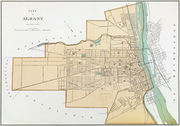
Albany has been a center of transportation for much of its history. In the late 18th and early 19th century, Albany saw development of the turnpike, a well-graded, prepared, toll road; most were initially owned by private companies, though all were eventually taken over by some government entity. By 1815, Albany was the turnpike center of the state. The development of Simeon De Witt's gridded block system in 1794, which gave Albany its original bird and mammal street names,[Note 8] was intersected by these important arterials coming out of Albany. To this day, the odd directions of Delaware Avenue (former Delaware Turnpike, 1805), Western Avenue (former Great Western Turnpike, 1799), Central Avenue (former Albany-Schenectady Turnpike, 1797), and New Scotland Avenue (former Schoharie Turnpike, 1790s) still exist, cutting through the city at unexpected angles.[36][37][38] The advent of the turnpike, in conjunction with canal and railroad systems, made Albany the hub of transportation for pioneers going to Buffalo and the Michigan Territory in the early and mid 19th century.[36][39]

In 1807, Robert Fulton initiated a steamboat line from New York to Albany, the first successful enterprise of its kind.[40] By 1810, with 10,763 people, Albany was the 10th largest urban place in the nation.[41] In 1825 the Erie Canal was completed, forming a continuous water route from the Great Lakes to New York City. Unlike the current Barge Canal, which ends at nearby Waterford, the original Erie Canal ended at Albany; Lock 1 was located north of Colonie Street.[42] The Canal emptied into a 32-acre (13 ha) man-made lagoon called the Albany Basin, which was Albany's main port from 1825 until the Port of Albany-Rensselaer opened in 1932.[43][44] In the 1830 and 1840 censuses, Albany moved up to 9th largest urban place in the nation,[45][46] then back to 10th in 1850.[47] This was the last time the city was one of the top ten largest urban places in the nation.[48]
Albany also has significant history with rail transport,[49] as the location of two major regional railroad headquarters. The Delaware and Hudson Railway was headquartered in Albany at what is now the SUNY System Administration Building.[50] In 1853, Erastus Corning, a noted industrialist and Albany's mayor from 1834 to 1837, consolidated ten railroads stretching from Albany to Buffalo into the New York Central Railroad (NYCRR), headquartered in Albany until Cornelius Vanderbilt moved it to New York City in 1867.[51][52] One of the ten companies that formed the NYCRR was the Mohawk and Hudson Railroad, which was the first railroad in the state and the first successful steam railroad running regularly-scheduled service in the country.[53][54]
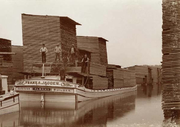
While the key to Albany's economic prosperity in the 19th century was transportation, industry and business also played a role. Largely thanks to the city's Dutch and German roots, beer was one of its biggest commodities. Beverwyck Brewery, originally known as Quinn and Nolan (Nolan being mayor of Albany 1878–1883),[56] was the last remaining brewer from that time when it closed in 1972. The city's location at the east end of the Erie Canal gave it unparalleled access to both raw products and a captive customer base in the west.[57] Albany was known for its publishing houses, and to some extent, still is. Albany was second only to Boston in the number of books produced for most of the 19th century.[58] Iron foundries in both the north and south ends of the city brought thousands of immigrants. To this day, one can see many intricate wrought-iron details on older buildings and houses. The iron industry waned by the 1890s, falling victim to the costs associated with a newly unionized workforce and the opening of mines in the Mesabi Range in Minnesota.[59] Albany's other major exports during the 18th and 19th centuries were furs, wheat, meat and lumber;[60] by 1865, there were almost 4,000 saw mills in the Albany area[60] and the Albany Lumber District was the largest lumber market in the nation.[55] Albany was home to a number of banks. The Bank of Albany (1792–1861) was the second chartered bank in New York.[61] The Albany Savings Bank, later known as Albank, was founded in 1820, and was acquired by Charter One Financial in 1998.[62] KeyBank was founded in 1825 as the Commercial Bank of Albany, which merged with Society for Savings and moved its headquarters to Cleveland in 1994.[63] The State Bank of Albany (1803), which became Norstar Bank in 1982, merged with Fleet Bank in 1989 and was bought by Bank of America in 2004.[64] American Express was originally founded in Albany in 1850 as an express mail business.[65]
Albany opened one of the first commercial airports in the world, and the first municipal airport in the United States, in 1908. Originally located on a polo field on Loudon Road, it moved to Westerlo Island in 1909 and remained there until 1928. The Albany Municipal Airport, jointly owned by the city and county, was moved to its current location in Colonie in 1928. In 1960, the mayor sold the city's stake in the airport to the county, citing budget issues. It was known from then on as Albany County Airport until a massive upgrade and modernization project between 1996 and 1998, when it was rechristened Albany International Airport.[66]
The Corning administration (1942) to present day

Erastus Corning 2nd, arguably Albany's most notable mayor (and great-grandson of the former mayor of the same name), was elected in 1941.[68] Although he was the longest serving mayor of any city in United States history (1942 until his death in 1983), one historian describes Corning's tenure as "long on years, short on accomplishments,"[67] citing Corning's preference for maintaining the status quo as a factor that held back potential progress during his tenure.[69] While Corning brought stability to the office of mayor, even those that idolize him cannot come up with a sizable list of "major concrete Corning achievements."[70] Corning is given credit for saving, albeit somewhat unintentionally, much of Albany's historic architecture.[Note 9]
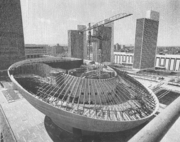
During the 1950s and 1960s, "a prosperous post-war era when other cities were tapping into a torrent of federal aid for urban renewal with the giddiness of children opening presents on Christmas morning,"[69] Albany did not see much progress in either commerce or infrastructure. It lost more than 20 percent of its population during the Corning years, and most of the downtown businesses moved to the suburbs.[72] While cities across the country experienced similar issues, the problems were magnified in Albany: interference from the Democratic political machine hindered progress considerably. For example, large retailers Macy's and Sears opened at suburban Colonie Center instead of moving into downtown as they had originally planned, due to the machine's influence.[69] Governor Nelson Rockefeller (1959–1973) (R), whose preference for grandiose, monumental architecture and large, government-sponsored building projects, supported the construction of the Empire State Plaza, SUNY Albany's uptown campus, and much of the W. Averell Harriman State Office Building Campus.[73] Albany County Republican Chairman Joseph C. Frangella once quipped, "Governor Rockefeller was the best mayor Albany ever had."[74] Corning, though opposed to the project, was responsible for negotiating the payment plan for the Empire State Plaza. Rockefeller did not want to be limited by the Legislature's power of the purse, so Corning devised a plan to have the county pay for the construction and have the state sign a lease-ownership agreement. The state would pay off the bonds until 2004. It was Rockefeller's only viable option, and he agreed. Due to the clout Corning gained from the situation, he was able to get the State Museum, a convention center, and a restaurant, back in the plans—ideas which Rockefeller had originally vetoed. The county gained $35 million in fees and the city received $13 million for lost tax revenue.[75]

Another major project of the 1960s and 1970s was Interstate 787 and the South Mall Arterial,[Note 10] which connect downtown and the Empire State Plaza to the New York State Thruway to the south and Troy to the north. Construction began in the early 1960s when I-787 was connected to Bassett Street. The project separated the city from the Hudson River. Corning is sometimes called shortsighted with respect to use of the waterfront, as he could have used his influence to change the location of I-787, which now cuts the city off from "its whole raison d'être".[76] Part of the original plan never came to fruition: Rockefeller had wanted the South Mall Arterial to pass through the Empire State Plaza. The project would have required an underground trumpet interchange below Washington Park, connecting to the (also cancelled) Mid-Crosstown Arterial.[77] To this day, evidence of the original plan is still visible.[Note 11]
When Corning died in 1983, Thomas Whalen assumed the mayorship and was reelected twice. Albany saw a significant influx of federal dollars earmarked for restoring historic structures. What Corning had saved from destruction, Whalen refurbished.[78] The Mayor's Office of Special Events was created in an effort to increase the number festivals and artistic events in the city, including a year-long Dongan Charter tricentennial celebration in 1986.[79] Whalen is credited for an "unparalleled cycle of commercial investment and development" in Albany due to his "aggressive business development programs".[80]
Prior to the recession of the 1990s, Albany was home to two Fortune 500 companies: KeyBank and Fleet Bank; both have since moved or merged with other banks.[81] Albany saw its political climate change after the death of Corning and the retirement of Congressman Sam Stratton. Long-term office holders became a thing of the past in the 1980s. Local media began following the drama surrounding county politics (specifically that of the newly-created county executive position); the loss of Corning (and eventually the machine) led to a lack of interest in city politics.[82] The 1990s brought about the surprise election of Gerald Jennings, who has been mayor since 1994. His tenure has essentially ended the political machine that had been in place since the 1920s.[83] During the 1990s, the Legislature approved the $234 million "Albany Plan", "a building and renovation project [that] was the most ambitious building project to effect the area since the Rockefeller era." The Albany Plan saw the initiation of renovation and new building projects around the downtown area, and the move of many state workers from the Harriman State Office Campus to downtown.[84] The late 2000s saw a real possibility for a long-discussed and controversial Albany Convention Center; as of August 2010, the Albany Convention Center Authority has already purchased 75% of the land needed to build the downtown project.[85]

Geography
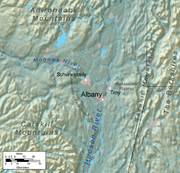
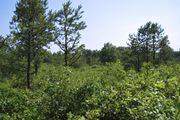
Albany is located about 150 miles (240 km) north of New York City on the Hudson River.[16] It has a total area of 21.8 square miles (56 km2), of which 21.4 square miles (55 km2) is land and 0.4 square miles (1.0 km2) (1.8%) is water.[87] The city is bordered on the north by the town of Colonie (along with the village of Menands), on the west by the town of Guilderland, and on the south by the town of Bethlehem.[88] The Hudson River represents the city's eastern border. Patroon Creek, along the northern border, and the Normans Kill, along the southern border, are the two major streams in the city. The former Foxes Creek, Beaver Kill, and Rutten Kill still exist, but were diverted underground in the 19th century.[89][90][91] There are four lakes within city limits: Buckingham Lake; Rensselaer Lake and Tivoli Lake along Patroon Creek; and Washington Park Lake, which was formed by damming the Beaver Kill.[88][90]
The highest natural point in Albany is an unnamed hill in the northernwest corner of the city (near the intersection of Old State Road and New Karner Road), at 324 feet (99 m) above sea level. The lowest point is sea level at the Hudson River,[88] which is still technically an estuary at Albany and is affected by the Atlantic tide.[92] The interior of Albany consists of rolling hills which were once part of the Albany Pine Bush, an area of pitch pine and scrub oak, and has arid, sandy soil that is a remnant of the ancient Lake Albany. Due to development, the Pine Bush has shrunk from an original 25,000 acres (10,000 ha) to 6,000 acres (2,400 ha) today. A preserve was set up by the State Legislature in 1988 and is located on the western edge of the city, spilling into Guilderland and Colonie;[93] it is the only sizable inland pine barrens and sand dunes in the United States,[86] and is home to many endangered species, including the Karner Blue butterfly.[94]
Climate
Albany is located in the humid continental climate zone (Köppen climate classification: Dfb), and has cold, snowy winters, and hot, wet summers; the city experiences four distinct seasons.[95] Albany is located in plant hardiness zone 5a near downtown and 5b at its western end.[96] Albany receives 38.6 inches (98 cm) of rain per year, with 137 days of at least 0.01 inches (0.025 cm) of precipitation each year.[97] Snowfall is significant, totaling 62.7 inches (159 cm) annually,[97] but with less accumulation than the lake-effect areas to the north and west, as it is further from Lake Ontario. Albany is close enough to the Atlantic coast to receive heavy snow from Nor'easters. The city occasionally receives Alberta clippers.[98] Winters can be very cold with fluctuating conditions; temperatures often drop below 0 °F (−18 °C) at night. Summers in Albany can contain stretches of excessive heat and humidity, with temperatures above 90 °F (32 °C). Record temperature extremes range from −28 °F (−33 °C) on January 19, 1971, to greater than 100 °F (38 °C) on September 3, 1953.[97]
| Climate data for Albany | |||||||||||||
|---|---|---|---|---|---|---|---|---|---|---|---|---|---|
| Month | Jan | Feb | Mar | Apr | May | Jun | Jul | Aug | Sep | Oct | Nov | Dec | Year |
| Record high °F (°C) | 65 (18.3) |
68 (20) |
89 (31.7) |
93 (33.9) |
94 (34.4) |
99 (37.2) |
100 (37.8) |
99 (37.2) |
100 (37.8) |
91 (32.8) |
82 (27.8) |
71 (21.7) |
100 (37.8) |
| Average high °F (°C) | 31.1 (-0.5) |
34.3 (1.28) |
44.5 (6.94) |
57.3 (14.06) |
69.8 (21) |
77.5 (25.28) |
82.2 (27.89) |
79.7 (26.5) |
71.3 (21.83) |
59.7 (15.39) |
47.5 (8.61) |
36 (2.2) |
57.6 (14.22) |
| Average low °F (°C) | 13.3 (-10.39) |
15.7 (-9.06) |
25.4 (-3.67) |
35.9 (2.17) |
46.5 (8.06) |
55 (12.8) |
60 (15.6) |
58.3 (14.61) |
49.9 (9.94) |
38.8 (3.78) |
30.8 (-0.67) |
20.1 (-6.61) |
37.5 (3.06) |
| Record low °F (°C) | -28 (-33.3) |
-22 (-30) |
-21 (-29.4) |
10 (-12.2) |
26 (-3.3) |
27 (-2.8) |
40 (4.4) |
34 (1.1) |
24 (-4.4) |
16 (-8.9) |
-11 (-23.9) |
-22 (-30) |
-28 (-33.3) |
| Precipitation inches (mm) | 2.71 (68.8) |
2.27 (57.7) |
3.17 (80.5) |
3.25 (82.6) |
3.67 (93.2) |
3.74 (95) |
3.50 (88.9) |
3.68 (93.5) |
3.31 (84.1) |
3.23 (82) |
3.31 (84.1) |
2.76 (70.1) |
38.6 (980) |
| Snowfall inches (cm) | 17.7 (45) |
12.8 (32.5) |
10.9 (27.7) |
2.9 (7.4) |
0.1 (0.3) |
0 (0) |
0 (0) |
0 (0) |
0 (0) |
0.2 (0.5) |
5.1 (13) |
13 (33) |
62.7 (159.3) |
| Avg. precipitation days | 12.8 | 10.2 | 12.2 | 11.9 | 13 | 11.6 | 10.4 | 10.8 | 10.7 | 9.7 | 11.6 | 12.1 | 137 |
| Avg. snowy days | 10.3 | 7.3 | 5.9 | 1.5 | 0.1 | 0 | 0 | 0 | 0 | 0.1 | 2.9 | 7.6 | 35.7 |
| Sunshine hours | 142.6 | 161.0 | 201.5 | 219.0 | 248.0 | 261.0 | 288.3 | 254.2 | 210.0 | 167.4 | 102.0 | 108.5 | 2,363.5 |
| Source #1: NOAA[97] | |||||||||||||
| Source #2: HKO[99] | |||||||||||||
Cityscape

Neighborhoods
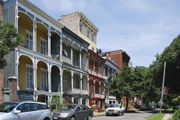
Albany's neighborhoods are varied demographically, geographically, architecturally, and historically. Downtown Albany is the city's oldest neighborhood, centered on State Street, one of Albany's oldest streets and its original main street. Today downtown consists mostly of office buildings inhabited by state agencies, though a recent push to bring in permanent residents has led to proposed apartments and condominiums, many of which have failed to get past the proposal phase.[100][101] North and south of Downtown are old residential communities often consisting of row houses. North is Sheridan Hollow, Arbor Hill, and North Albany; to the south is the super-neighborhood of the South End, which consists of a multitude of smaller neighborhoods including the Mansion District, the Pastures, Kenwood, Groesbeckville, Delaware Avenue, and Krank Park.[102][103] These neighborhoods tend to have more minorities and lower-income residents than the western, more suburbanized part of the city.[104]
West of Downtown is the Empire State Plaza, which effectively cuts Downtown off from the gentrified neighborhoods of Center Square, Hudson/Park, Lark Street, and Washington Park. Collectively referred to as mid-town, these neighborhoods are often compared to New York City's Greenwich Village for their eclectic mix of residential and commercial uses, including bars, night clubs, restaurants, and unique stores. Albany's gay culture is vibrant in this area.[105] Nearby Park South, a nine-block area surrounding New Scotland Avenue[103] and home to roughly 1,000 individuals, is currently undergoing an urban renewal as existing housing units are removed or renovated and new office, commercial, and apartment buildings are added.[106] New construction includes expansion of Albany Medical Center, one of the largest employers in Albany. Nearby is University Heights, a united campus consisting of Albany Medical Center Hospital, Albany Medical College, Albany Law School, Albany College of Pharmacy, and the Sage College of Albany.[107]

Single-family detached homes, duplexes, and apartments, along with single-family houses that have been carved up into multiple units, can be found west of the older neighborhoods. These neighborhoods, such as Pine Hills, Delaware Avenue, Whitehall, Helderberg, New Scotland, and Beverwyck, tend to have larger lots and more suburban surroundings.[102] The Eastern section of Pine Hills is often referred to as the "student ghetto" due to the proximity of the campuses of Saint Rose College and University at Albany. The area from North Main to South Lake between Myrtle and Washington avenues has become home to off-campus college students living in houses carved into multiple units by absentee landlords.[108]
Further west, the neighborhoods become more affluent and are dominated almost exclusively by single-family dwellings. These neighborhoods, such as Melrose, Western Pine Hills, New Albany, Eagle Hill, Westland Park, Campus, and Buckingham Park, have some of the quieter streets and larger lots in the city, and more closely resemble neighboring areas of the suburban towns than they do the downtown parts of the city.[102] Further west is the W. Averell Harriman State Office Campus and the University at Albany's main campus. West of those campuses are offices and commercial properties lining frontage roads along Washington Avenue Extension, with a small housing development called The Dunes, all surrounded by the Pine Bush Preserve.[103][109]
Parks and recreation
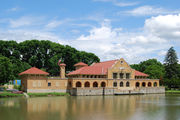
Albany has over 60 public parks and recreation areas.[111] Washington Park was organized as the Middle Public Square in 1806. Its current location has been public property since the Dongan Charter of 1686 gave the city title to all property not privately owned. Washington Park's current layout was designed by John Bogart and John Cuyler in 1870,[112] and the park was opened for public use in 1871. The lake house, designed by Frederick W. Brown, was added in 1876. The park had previously been used as a cemetery; its graves were moved to Albany Rural Cemetery. Washington Park is a popular place to exercise and play sports; skate during the winter; people-watch during Tulip Fest; and attend plays at the amphitheater during the summer.[112][113][114][115]
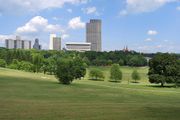
Other parks in Albany include Lincoln Park, Buckingham Park, the Corning Preserve, and the Pine Bush. Lincoln Park, located directly southwest of the Empire State Plaza, was organized in 1886 and was originally known as Delaware Square and then later as Beaver Park.[116] Today, the park has a pool that is open during the summer months. Buckingham Lake Park is located between Manning Boulevard and Route 85 in the Buckingham Pond neighborhood; it contains a pond with fountains, a footpath, a playground, and picnic tables.[117] The Albany Riverfront Park at the Corning Preserve is home to an 800-seat amphitheatre that hosts numerous events throughout non-winter months, most notably the Alive at 5 summer concert series. The Corning Preserve is home to a visitors center that details the ecology of the Hudson River and the local environment.[118] The park features a bike trail and boat launch[118] and was effectively separated from downtown by Interstate 787 until the opening of the Hudson River Way in 2002.[119]
Other public parks include Westland Hill Park, Hoffman Park, Beverwyck Park, Ridgefield Park,[120] and Liberty Park, today a small circular grassy patch in downtown on Hudson Avenue, which is Albany's oldest park.[121]
Architecture
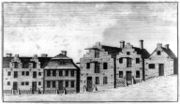
The Empire State Plaza, a collection of state agency office buildings, dominates almost any view of Albany. Built between 1965 and 1978 at the hand of Governor Nelson A. Rockefeller and architect Wallace Harrison, the complex is a powerful example of late American modern architecture.[71] Originally owned by Albany County, the state paid the county rent by paying off the construction bonds; once the bonds were paid off in 2004 the state took full ownership.[122] The complex includes the Erastus Corning Tower, the tallest building in the city; four identical agency buildings; the Legislative Office Building; the Robert Abrams Building for Law and Justice; the Swan Street Building; the Cultural Education Center, which houses the State Museum, State Archives, and State Library; and The Egg, a performing arts venue.[71] Juxtaposed at the north end of the Plaza is the 19th-century New York State Capitol, the seat of the New York State Legislature and the home of the Governor's office.[123]
Albany's initial architecture incorporated many Dutch influences, followed soon after by those of the English. The Quackenbush House, a Dutch Colonial brick mansion, was built c. 1736.[124] Schuyler Mansion, a 1765 Georgian mansion, was built for Philip Schuyler, an American general during the Revolutionary War and later a United States Senator from New York; it became a National Historic Landmark in 1979.[125] The oldest building currently standing in Albany is the Van Ostrande-Radliff House at 48 Hudson Avenue;[126] scientific testing estimates it was built in 1728.[127]
Albany City Hall, a Richardsonian Romanesque structure designed by Henry Hobson Richardson and opened in 1883, houses Albany's city government. The New York State Capitol was opened in 1899 (after 32 years of construction[123]) at a cost of $25 million, making it the most expensive government building at the time.[128] So notable were these two buildings in their day that in 1885 American Architect and Building News listed them among the top ten most beautiful buildings in the country.[129] Albany's Union Station, a major Beaux-Arts design,[130] was under construction at the same time; it opened in 1900. It was said that "perhaps no other building has been so important to the growth of Albany during the twentieth century as Union Station."[131]
Albany's housing varies greatly, with mostly row houses in the older sections of town, closer to the river. The change in housing type looks like "ripples of housing styles radiating from downtown," with the row houses in the first ring. The second ring includes a surge in two-family homes in the late 19th century, which were serviced by electric street cars. Automobiles made it possible to move even further from downtown; outside the two-family home ring is a ring of one-family homes that were first built after World War II and are still being built today.[132]
The Washington Avenue Armory opened in 1891; technically a Romanesque Revival design, its architect, Isaac Perry, was strongly influenced by Henry Richardson, who had previously worked with Perry on the State Capitol. Today the Armory is an entertainment venue.[133] In 1912, the Beaux-Arts styled New York State Department of Education Building opened on Washington Avenue near the Capitol. It has a classical exterior, which features a block-long white marble colonnade.[134] The 1920s brought the Art Deco movement, which is illustrated by the Home Savings Bank Building (1927) on North Pearl Street[135] and the Alfred E. Smith Building (1930) on South Swan Street,[136] two of Albany's tallest high-rises.[137]
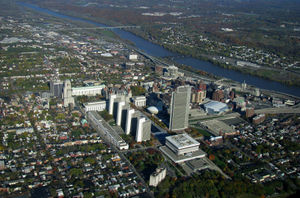
Architecture from the 1960s and 1970s is well represented in the city, especially at the W. Averell Harriman State Office Building Campus (1950s and 1960s) and on the uptown campus of the University at Albany (1962–1971). The state office campus, occupying a piece of land totaling nearly 330 acres (130 ha), is home to over 7,000 employees in approximately 16 buildings comprising about 3 million square feet (280,000 m²) of office space.[138][139] It is a suburban-style, car-oriented campus bordered by an outer ring road that cuts the campus off from the surrounding neighborhoods. The state office campus was planned in the 1950s by governor W. Averell Harriman to offer more parking and easier access for state employees. The first building was built in 1956, but most of the buildings were built in the 1960s under Governor Rockefeller.[140]
The uptown SUNY campus was built in the 1960s under Governor Nelson Rockefeller on the site of the city-owned Albany Country Club. Straying from the open campus layout made popular by both Union College in Schenectady and the University of Virginia in Charlottesville, Virginia, SUNY Albany has a centralized building layout. At its core is a large "podium" containing the academic and administrative buildings. Four dormitory complexes, each centered by a high-rise housing tower surrounded by a low-rise grouping of support buildings, are located at each corner of the podium. The architecture called for much use of concrete and glass, and the style has slender, round-topped columns and pillars reminiscent of those at Lincoln Center in New York City.[141]
Downtown Albany has seen a revival in recent decades, often considered to have begun with Norstar Bank's renovation of the former Union Station as its corporate headquarters in 1986.[Note 12] The Times Union Center (TU Center), originally known as Knickerbocker Arena, was once slated for suburban Colonie,[143] but was instead built downtown and opened in 1990.[144] The TU Center, on South Pearl Street, and the renovated Palace Theatre (2003 renovation),[145] on North Pearl Street, have anchored Pearl Street (around State Street) as an entertainment district with many bars and restaurants. Downtown has benefited from the Alive at 5 summer concert series, which takes place at the Corning Preserve, and the block party that follows each show on North Pearl Street.[146] Other development in downtown includes the construction of the Dormitory Authority headquarters at 515 Broadway (1998);[147] the Department of Environmental Conservation building, with its iconic green dome, at 625 Broadway (2001);[148] the State Comptroller headquarters on State Street (2001);[149] the Hudson River Way (2002), a pedestrian bridge connecting Broadway to the Corning Preserve;[119] 677 Broadway (2005), "the first privately owned downtown office building in a generation";[146][150] and a Hampton Inn & Suites (2005) on Chapel Street.[146]
Demographics
| Historical populations | |||
|---|---|---|---|
| Census | Pop. | %± | |
| 1790 | 3,498 |
|
|
| 1800 | 5,349 | 52.9% | |
| 1810 | 10,762 | 101.2% | |
| 1820 | 12,630 | 17.4% | |
| 1830 | 24,209 | 91.7% | |
| 1840 | 33,721 | 39.3% | |
| 1850 | 50,763 | 50.5% | |
| 1860 | 62,367 | 22.9% | |
| 1870 | 69,422 | 11.3% | |
| 1880 | 90,758 | 30.7% | |
| 1890 | 94,923 | 4.6% | |
| 1900 | 94,151 | −0.8% | |
| 1910 | 100,253 | 6.5% | |
| 1920 | 113,344 | 13.1% | |
| 1930 | 127,412 | 12.4% | |
| 1940 | 130,577 | 2.5% | |
| 1950 | 134,995 | 3.4% | |
| 1960 | 129,726 | −3.9% | |
| 1970 | 115,781 | −10.7% | |
| 1980 | 101,727 | −12.1% | |
| 1990 | 101,082 | −0.6% | |
| 2000 | 95,658 | −5.4% | |
| Est. 2008 | 93,539 | [151] | −2.2% |
| Sources: 1790–1950,[152] 1960–1980,[153] 1990–2000[151] |
|||
Immigrant city
Historically, Albany's population has been mixed. First dominated by the Dutch and Germans, it was overtaken by the English in the early 19th century. Irish immigrants soon outnumbered most other ethnicities by the mid 19th century, just as Italians and Poles started moving in. The mid to late 20th century saw a rise in the African American population. As historian John McEneny put it, "Dutch and Yankee, German and Irish, Polish and Italian, black and Chinese—over the centuries Albany's heritage has reflected a succession of immigrant nationalities. Its streets have echoed with a dozen languages, its neighborhoods adapting to the distinctive life-style and changing economic fortunes of each new group."[154]
Until after the Revolution, Albany's population consisted mostly of Dutch descendants. Settlers moving in from New England tipped the balance toward the English in the early 19th century.[155] Jobs on the turnpikes, canals, and railroads brought in floods of Irish immigrants in the early 19th century, especially in the 1840s during the Irish potato famine, solidifying the city's Irish base; Albany elected its first Irish Catholic mayor (Michael Nolan) two years before Boston did.[156] Polish and Italian immigrants began arriving in Albany in the latter part of the 19th century. Their numbers were smaller than in many other eastern cities mainly because most of them had found jobs at General Electric in Schenectady.[157] The Jewish community, present since the days of Beverwijck, also saw a rise in population during the 19th century.[157] Albany saw an influx of Chinese and east Asian immigrants in the downtown section of the city at this time, though that population has since spread out significantly.[158] Immigration all but halted after the Immigration Act of 1924, but Albany did see its last large immigration pattern by African Americans moving in from the American South to fill industrial positions before World War I. As a percentage, the black community has grown substantially since then, ranging from 3 percent of the population in 1950, 6 percent in 1960, 12 percent in 1970, and more than 28 percent in 2000. This is mainly due to middle class white families moving to the suburbs and black families remaining within city limits during the same time period.[159][151]
Current overview
As of the 2000 census,[151] there were 95,658 people, 40,709 households, and 18,397 families residing in the city; the 2008 census estimate puts the city population at 93,539.[151] The population of the metro area in 2009 was estimated to be 857,592.[160] The population density in 2000 was 4,474.6/sq mi (1,727.5/km²). There were 45,288 housing units at an average density of 2,118.4/sq mi (817.9/km²); 4,579 of these units (10.1%) were vacant. The racial makeup of the city residents was 63.12% white; 28.14% black or African American; 0.32% Native American or Native Alaskan; 3.26% Asian; 0.04% Native Hawaiian or Pacific Islander; 2.15% from other races; and 2.98% from two or more races. A total of 5.59% of the population were Hispanic or Latino of any race.[Note 13] The top five ancestry groups in the city were Irish (18.1%), Italian (12.4%), German (10.4%), English (5.2%), and Polish (4.3%); 33.1% of the population reported "other ancestries". The population had 20.0% under the age of 18, 19.3% from 18 to 24, 29.2% from 25 to 44, 18.1% from 45 to 64, and 13.4% who were 65 years of age or older. The median age was 31.4 years. For every 100 females there were 90.6 males. For every 100 females age 18 and over, there were 86.5 males. Some 81.3% of the population had completed high school or earned an equivalency diploma.[151]
There were 40,709 households, out of which 22.0% had children under the age of 18 living with them, 25.3% were married couples living together, 16.1% had a female householder with no husband present, and 54.8% were non-families. 41.9% of all households were made up of individuals and 11.5% had someone living alone who was 65 years of age or older. The average household size was 2.11 and the average family size was 2.95.[151]
The median income for a household in the city was $39,593, and the median income for a family was $41,562 (male, year-round worker) and $35,733 (female, year-round worker). The per capita income for the city was $24,094.[Note 14] About 16.0% of families and 21.7% of the population were below the poverty line, including 28.8% of those under age 18 and 12.5% of those age 65 or over.[151] Rates of reported violent crimes for 2008 (1,095 incidents per 100,000 residents) is more than double the rate for similarly sized US cities. Reported property crimes (4,669 incidents per 100,000 residents) are somewhat lower.[161][162]
Demographically speaking, the population of Albany and the Capital District mirrors the characteristics of the United States consumer population as a whole better than any other major municipality in the country. According to a 2004 study conducted by the Acxiom Corporation, Albany and its environs are the top-ranked standard test market for new business and retail products. Albany, Rochester, and Syracuse all made the top five.[163]
Culture
Nightlife and entertainment
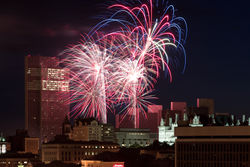
Albany's geographic situation—roughly equidistant between New York City to the south and Montreal to the north, as well as Buffalo to the west and Boston to the east—makes it a convenient stop for nationally touring artists and acts. The Palace Theatre and The Egg provide mid-sized forums for music, theater, and spoken word performances, with the Capital Repertory Theatre filling the small-sized niche.[165] The TU Center serves as the city's largest musical venue for nationally and internationally prominent bands, and hosts trade shows, sporting events, and other large-scale community gatherings.[166] Two independent movie theaters operate within the city: the Madison Theater[167] and the Spectrum 8 Theatre.[168] While some praise the cultural contributions of Albany and the greater Capital District,[79] others suggest that the city has a "cultural identity crisis" due to its massive geography and the need for a car (and driving time) to experience most of what the area has to offer, a necessity not seen in larger metropolitan areas like New York and Boston.[169]
In recent years, the city's government has invested resources to cultivate venues and neighborhoods that attract after-hours business. Madison Avenue, Pearl Street, Delaware Avenue and Lark Street serve as the most active entertainment areas in the city. Many restaurants, clubs, and bars have opened since the mid 1990s, revitalizing numerous areas that had once been abandoned; various establishments have reclaimed old row houses, businesses, and even a pump station.[165] The bar scene generally incorporates three main strips. The typical downtown scene is found on Pearl Street, stretching about two blocks. Up State Street, past the business district is the Lark Street strip, home to smaller and typically more aesthetic bars, fitting into the neighborhood's artistic and eclectic reputation. Lastly the midtown strip, with several bars located on Western and Madison Avenues, centers around the campuses of the College of Saint Rose and SUNY Albany's downtown campus. The midtown strip generally draws a younger crowd, as it is popular to the local college students.[170]
Notably, last call in Albany is 4:00 am nightly. This is often attributed to the historical high density of industrial facilities and the demands of second- and third-shift patrons. New York law allows bars to be open until 4:00 am, though local municipalities reserve the right to override this law and designate an earlier time. Though this law was designed to accommodate the nightlife of New York City, Albany has adopted it in an effort to promote downtown nightlife (and to a lesser extent, because it is typically difficult to clear the streets of bar patrons).[170]
Festivals
The Tulip Festival, one of Albany's largest festivals, is set in Washington Park. This traditional Albany event marks the beginning of spring as thousands of tulips bloom in the park in early May. The day features musical performances and the coronation of the Tulip Queen. Tulip Fest is a celebration of Albany's rich Dutch heritage, and draws both local and regional attendance.[171] Alive at 5 is a free concert series held downtown on Thursday evenings throughout the summer. The concert series features local, regional, and national artists and hosts different genres of music each week.[172] The Price Chopper Fabulous Fourth and Fireworks Festival at the Empire State Plaza celebrates Independence Day with musical performances and the region's largest fireworks display.[164] Freihofer's Run for Women is a 5-kilometer run through the city that draws more than 4,000 participants from across the country; it is an annual event that began in 1978.[173]
Smaller events include the African American Family Day Arts Festival each August at the Empire State Plaza;[164] the Latin Fest, held each August at the Corning Preserve;[174] the Albany Jazz Festival, an annual end-of-summer event held at the Corning Preserve;[175] Lark Fest, a music and art festival held each fall;[176] and the Capital Pride Parade and Festival, a major gay pride event, held each June.[177] The once-popular First Night, celebrating the New Year holiday each December 31, was replaced by the Albany Winterfest in 2006 due to declining interest;[178] Winterfest occurs each year on December 30.[179]
Museums and historic sites

Because of Albany's historical and political significance, the city has numerous museums, historical buildings, and historic districts. Albany is home to the New York State Museum and New York State Archives, both open to the public. The USS Slater (DE-766), a decommissioned World War II destroyer escort that was restored in 1998, is a museum ship docked in the Hudson River at Quay Street. It is the only ship of its kind still afloat.[181] The Albany Heritage Area Visitors Center, located at the corner of Clinton Avenue and Broadway at Quackenbush Square, hosts a museum, gift shop, and the Henry Hudson Planetarium;[182] Quackenbush Square is the docking point for the Albany Aqua Ducks, a company that offers boat and trolley tours of the city.[183]
Albany is home to 57 listings on the National Register of Historic Places[184] (NRHP) and five National Historic Landmarks.[185] The Ten Broeck Mansion, a 1797 Federal-style mansion (later renovated in the Greek-Revival style) built for Abraham Ten Broeck—a two-time mayor of Albany (1779–1783 and 1796–1798) and administrator of the Manor of Rensselaerswyck until Stephen Van Rensselaer reached the age of majority[186]—is currently a historic house museum and the headquarters of the Albany County Historical Association;[180] it was added to the NRHP in 1971.[187] Later known as "Arbor Hill", it gave the current neighborhood[Note 15] its name.[188]
Literature and film
Albany has been the subject, inspiration, or location for many written and cinematic works. Many non-fiction works have been written on the city. One of the city's more notable claims to fame is Ironweed (1983), the 1984 Pulitzer Prize-winning book by Albany native William Kennedy. Ironweed was the third in a series of books by Kennedy known as the "Albany Cycle".[189][190] The elusive author Trevanian also grew up in Albany and wrote The Crazyladies of Pearl Street (2005), about a North Albany neighborhood along Pearl Street. The book is considered a semi-autobiographical memoir.[191] Gregory Maguire, author of Wicked: The Life and Times of the Wicked Witch of the West (inspiration for the Broadway hit Wicked), grew up in North Albany[192] and graduated from SUNY Albany in 1976.[193]
In 1987, the film version of Ironweed premiered at the Palace Theatre.[194] The movie starred Jack Nicholson and Meryl Streep, each of whom were nominated for Academy Awards for their performances;[195] much of the filming was done on location in Albany.[194] Most recently the downtown area was the site of filming for the action-thriller Salt, starring Angelina Jolie,[196] and the action-comedy The Other Guys, starring Will Farrell and Mark Wahlberg.[197]
Education
The City School District of Albany (CSDA) operates the city's public school system, which consists of 18 schools and learning centers,[198] in addition to 11 charter schools.[Note 16] The number of students in CSDA has steadily decreased since 2000.[202][203][204] In the 2008–09 school year, 7,899 students were enrolled in the public school system.[202] The district had an average class size of 18,[202] an 81 percent graduation rate,[Note 17] and a 5 percent dropout rate.[205] The district's 2010–11 budget is $202.8 million.[206] Albany County is within the Capital Region BOCES,[207] which offers, among other services, the opportunity for high schoolers to attend Tech Valley High School, a technical, consortium high school located in Rensselaer that emphasizes STEM education through project-based learning.[208] Although considered by the state to be one of the lowest-achieving high schools in New York, Albany High was listed as the nation's 976th best high school in a 2010 Newsweek/Washington Post report.[209]
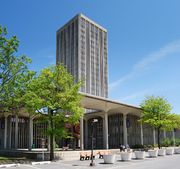
Albany has a number of private schools, including the coed Bishop Maginn High School and Albany Free School; the all-boys Albany Academy and La Salle School;[Note 18] and the all-girls Academy of the Holy Names and Albany Academy for Girls.[212]
Albany has a long history in higher education and was ranked third in a Forbes survey called "The Best Places With The Best Education" in 2005;[213] it ranked top on Forbes' "IQ Campuses" list as part of its 150 Cheap Places to Live series in 2006.[214] The Albany Medical College (private), today part of Albany Medical Center, was founded in 1838; it moved to its current location on New Scotland Avenue in 1927. Albany Law School (private) is the oldest law school in New York and the fourth oldest in the country; it was opened in 1851. President William McKinley is one of its alumni. The Albany College of Pharmacy and Health Sciences (private) is the second oldest pharmacy school in New York and the fifteenth oldest in the United States. It moved into its current building on New Scotland Avenue in 1927. Albany Law School, Albany College of Pharmacy, and Albany Medical Center, along with the Sage College of Albany, are all located on one mega-campus in the University Heights neighborhood. The New York State Normal School, one of the oldest teachers' colleges in the United States, opened in 1905; it was later known as the State Teachers College. It eventually evolved into the University at Albany, also known as SUNY Albany (public), which inherited the Normal School's original downtown campus on Western Avenue. The center of the campus moved to its current Uptown Campus in the west end of the city in 1970. The Downtown Campus is still very much a part of the university, however. SUNY Albany is the flagship campus of the State University of New York and one of only four university centers in the system.[210] Other colleges and universities in Albany include The College of Saint Rose, Excelsior College, Maria College, Mildred Elley, and Sage College of Albany. Nearby Hudson Valley Community College (HVCC) fills the community college niche in the Albany-Troy area.[215] The effect of the campuses on the city's population is substantial: Combining the student bodies of all the aforementioned campuses (except HVCC) results in 63,149 students, or almost 70 percent of the 2008 estimate of Albany's permanent population.[216]
Economy
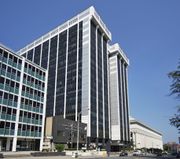
Albany's economy, along with that of the Capital District in general, is heavily dependent on government, health care, and education. Because of these typically steady economic bases, the local economy has been relatively immune to national economic recessions in the past.[218] More than 25 percent of the city's population works in government-related positions.[219] The current recession has been more difficult to deal with because of the many issues on Wall Street, from which the state government receives much of its tax revenue. As of March 2010[update], the Albany area had the lowest unemployment rate of any major metropolitan area in New York, at 7.8%, compared to 9.4% in New York as a whole.[220]
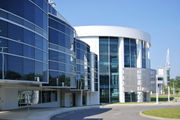
Due to lower tax revenue and other problems, state government has experienced a significant budget gap, forcing a hiring freeze in 2009[218] and discussions of furloughs and layoffs in 2010 and 2011 respectively.[221] The effect is felt at local universities, which have seen their endowments shrink.[218] The healthcare system has seen growth due to an aging baby boomer population.[218] Albany Medical Center and St. Peter's Healthcare Services, both headquartered in Albany, were the city's second and fourth largest employers in 2006.[222] Albany brings in many workers from outside the city. Its estimated daytime population is more than 162,000, which is almost 80% more than the 2008 population estimate.[223]
A growing fourth sector of the area's economic base is the emerging high-tech industry in and around Albany.[218] The city is at the center of a 19-county region in eastern New York self-branded as "Tech Valley" due to the growing number of companies, entrepreneurs, and research facilities focusing on high-tech industries including nanotechnology, biotechnology, homeland security, information technology, and alternative energy. Albany is increasingly seen as a leader in nanotechnology, with the University at Albany's College of Nanoscale Science and Engineering being respected as a national leader in the field. In 2006, Small Times magazine ranked the college as the best in the country for micro- and nanotechnology; the school was ranked top in education, facilities, and industry outreach.[224] In 2009, chipmaker GlobalFoundries broke ground on a $4.6 billion chip manufacturing complex in nearby Malta.[225] In 2010, Forbes ranked Albany fifteenth on its "Most Innovative Metros" list.[226]
In 2006 Forbes ranked the Albany-Schenectady-Troy MSA the 18th best place for business in the nation. It was the second highest ranking in the Northeastern United States and the highest in the state.[227] In 2009, Albany and its environs were listed number 30 in the nation on Forbes' "Best Bang-For-The-Buck" list, a study that looked at the stability of the housing and job markets, cost of living, and commute times. In the same study, the area was ranked fourth best for rate of foreclosures.[228] Albany was among the 25 strongest housing markets in the United States during the tough economic conditions of 2008.[229] According to the United States Census Bureau, the Capital District's gross domestic product (GDP) was $32.345 billion in 2008, up 3.4 percent from the year before. The region ranked 42nd in growth rate.[230]
Government
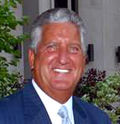

Albany has a mayor-council form of government, which currently functions under a charter adopted in 1998. The 1998 charter completely overwrote the original 17th-century Dongan Charter. In an effort to keep Dongan in effect, the new charter was applied as an amendment to Dongan, meaning Dongan is technically still in effect, giving Albany the distinction of having the oldest active city charter in the United States and "arguably the longest-running instrument of municipal government in the Western Hemisphere."[4][231] The mayor, who is elected every four years, heads the executive branch of city government.[232] The current mayor, Gerald Jennings, was elected in 1993.[233] The Common Council represents the legislative branch of city government and is made up of fifteen council members (each elected from one ward) and an at-large Common Council President.[231] The current president is Carolyn McLaughlin;[234] she began her term in January 2010.[235]
The city seal was adopted in 1789 and first appeared on Simeon De Witt's 1790 map of Albany. The city flag was adopted in 1909 as part of the tricentennial celebration of Hudson's voyage up the Hudson River. The flag is based on the flag of the Dutch East India Company, for which Hudson sailed, being a horizontal tricolour of orange, white, and blue, with the city's coat of arms in the center.[1][236]
While Albany has its own city government, it has also been the seat of Albany County since the county's formation in 1683 and the capital of New York since 1797. As such, the city is home to all branches of the county and state governments, as well as its own. Albany City Hall sits on Eagle Street, opposite the State Capitol,[237] and the Albany County Office Building is on State Street.[238] The state government has offices scattered throughout the city.
Albany is in the 21st Congressional district, and is represented by Paul Tonko (D) in the United States House of Representatives.[239] The city is represented by Chuck Schumer (D)[240] and Kirsten Gillibrand (D)[241] in the United States Senate. On the state level, the city is in the 46th district in the New York Senate, represented by Neil Breslin (D).[242] In the New York Assembly, about two-thirds of the western portion of the city is in the 104th district, represented by John McEneny (D),[243] and the eastern third is in the 106th district, represented by Ronald Canestrari (D).[244] As the seat of Albany County, the city is the location of the county's courts including Family Court, County Court, Surrogate Court, Supreme Court, and Court of Appeals.[245] Albany is the site of a United States district court for the Northern District of New York courthouse.[246]
Politics
Albany politics have been dominated by the Democratic Party since the 1920s; Daniel (Uncle Dan) O'Connell established a political machine in the city with the election of William Stormont Hackett as mayor in 1922.[247] Prior to that, William (Billy) Barnes had set up a Republican machine in the 1890s. Barnes' success is attributed to the fact that he owned two newspapers in Albany and that he was the grandson of Thurlow Weed, the influential newspaper publisher and political boss.[248] O'Connell's organization overcame Barnes' in 1922 and survived well into the 1980s (even after his death), as the machine put forth candidates for whom the electorate dutifully voted. In many instances, votes were bought;[249] it was not uncommon for the machine to "buy poor folks' loyalty and trust with a fiver".[250] Gerald Jennings' upset in the 1993 Democratic mayoral primary over Harold Joyce, who had the Democratic Party’s formal endorsement and had only recently been its county chairman, is often cited as the end of the O'Connell era in Albany.[251] Albany continues to be dominated by the Democratic party as enrollment in the city was 38,862 in 2009 compared to Republican enrollment of 3,487.[252] This gives Democrats a 10–1 advantage in the general election. Every elected city position has been held by a Democrat since 1931.[253]
Religious life
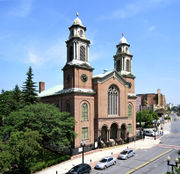
Like most cities of comparable age and size, Albany has well-established Catholic, Protestant, and Jewish communities. Albany is home to the oldest Christian congregation in upstate New York and the Mother Churches of two Christian diocese. As of June 2010[update], eight churches or religious buildings in the city were listed on the National Register of Historic Places,[184] one of which—St. Peter's Episcopal Church on State Street—is a National Historic Landmark.[185]
Established in 1642,[255] the congregation of the First Church in Albany (Reformed), also known as the North Dutch Church (located on North Pearl Street), is the second-oldest Reformed Church in America.[254] The Cathedral of the Immaculate Conception (Eagle Street and Madison Avenue, built 1852) is the cathedral of the Roman Catholic diocese, led by Bishop Howard J. Hubbard,[256][257] and the Cathedral of All Saints (South Swan Street and Elk Street, built 1888) is the cathedral of the Episcopal diocese, led by Bishop William Love.[258][259] The city is home to eleven Catholic churches[260] and six Episcopal churches.[261]
A significant Jewish presence has existed in Albany since as early as 1658,[262] and today includes many synagogues; there are two Reform, two Conservative, a Chabad-Lubavitch, an Orthodox, and one of the few Karaite synagogues outside Israel.[263][264] Albany's South End was the center of the Jewish community from the 1830s until the 1950s when the community moved to the Pine Hills and Delaware Avenue neighborhoods.[262] Although the synagogues in Albany may have a combined membership of between 12,000–13,000, about half of those actually live in the suburbs; however, unlike other communities around the country, Albany's Jewish infrastructure has remained within the city and has not relocated to the suburbs.[262]
There is a small population of Muslims in the city. The number of colleges and universities in the area help bring in more culturally diverse students, representing a range of religious beliefs. Most of the local colleges have Muslim Student Associations.[265] SUNY Albany even cancelled class for Eid al-Fitr and Eid al-Adha during the 2004–2005 school year, but it reverted that policy the following year after reconsideration of the low Muslim population.[266]
Exact numbers on religious denominations in Albany are not readily available. Demographic statistics in the United States depend heavily on the United States Census Bureau, which cannot ask about religious affiliation as part of its decennial census.[267] It does compile some national and state-wide religious statistics,[268] but these are not representative of a city the size of Albany. One report from 2000 offers religious affiliations for Albany County. According to the data, 59.2% of Albany County residents identified as Christian: 47% are Roman Catholic, 8.4% are mainline Protestants, 2.7% are Evangelical Protestants, and 1.1% are Eastern or Oriental Orthodox Christians. Residents who practice Judaism make up 4.2% of the population and Muslims represent 0.2%.[269] Note that these values are county-wide; city values could be significantly different.
Media
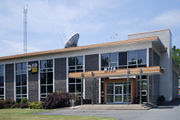
The Times Union is Albany's primary daily newspaper and the only one based close to the city; its headquarters moved from within city limits to suburban Colonie in the 1960s after a dispute with Mayor Corning over land needed for expansion.[270] Its circulation totals about 73,000 on weekdays and 143,000 on Sundays.[271] Serving Albany to a lesser degree are The Daily Gazette, based in Schenectady,[272] and The Record, of Troy.[273] Metroland is the alternative newsweekly in the area, publishing each Thursday,[274] while The Business Review is a business weekly published each Friday.[275] The Legislative Gazette, another weekly newspaper, focuses exclusively on issues related to the Legislature and the state government.[276]
The Albany-Schenectady-Troy media market is the 63rd largest in the country in terms of radio[277] and the 57th largest in terms of television audiences.[278] It is a broadcast market with historical significance. The pioneering influence of General Electric in Schenectady directly contributed to the area emerging as the birthplace of station-based television with WRGB; the station was also the first affiliate of NBC.[279] In 1947, the region was home to the first independently-owned and operated commercial FM radio station in the United States: W47A.[279] WGY was the second commercial radio station in New York and the twelfth in the nation.[279] The Capital District is home to ABC affiliate WTEN,[280] CBS affiliate WRGB,[281] Fox affiliate WXXA,[282] and NBC affiliate WNYT;[283] Time Warner Cable hosts Your News Now, the area's only local 24-hour news channel.[284]
Transportation
The Northway (Interstate 87 north of the New York State Thruway) connects Albany by car to Canada at Champlain; Autoroute 15 continues into Quebec, linking Albany to Montreal. Interstate 90 connects Albany to both Buffalo and Boston, via the New York State Thruway and the Mass Pike respectively. South of Albany, I-87 becomes part of the Thruway and ends at Interstate 278 in the Bronx. Albany is literally at the crossroad of I-87 and I-90, creating a junction between Buffalo and Boston, and Montreal and New York. Interstate 787 links Albany to Watervliet, Colonie, and Menands; by way of Alternate Route 7, I-787 connects to the Northway, offering Saratoga County residents a rather direct, albeit congested route to and from Albany during rush hour.[109]
Albany, situated on the Hudson River, has always used water as a means for transportation. Today the Port of Albany-Rensselaer, located on both the Albany and Rensselaer sides of the Hudson River, carries on the tradition by handling domestic and international ships and barges. The port has the largest mobile harbor crane in the state of New York.[286] The New York State Barge Canal, the ultimate successor of the Erie Canal, is still in use today, however its use is mainly limited to tourist and private boats.[287]

Despite Albany's important historical impact on railroads, Albany lacks its own railroad station today. Formerly serviced by Union Station on Broadway, Amtrak currently services the area through the Albany-Rensselaer station in Rensselaer. In 2009 the station was Amtrak's second busiest in New York, behind New York's Penn Station, with a ridership of over 720,000 passengers. Amtrak has several routes that service Albany-Rensselaer: the Adirondack, north to Montreal and south to New York City; the Empire Service, west to Buffalo and south to New York City; the Ethan Allen Express, northeast to Rutland, Vermont and south to New York City; the Maple Leaf, west to Toronto and south to New York City; and the Lake Shore Limited, west to Chicago and east splits to both Boston and New York City.[288]
Albany's nearest airport is Albany International Airport in Colonie. Eight major airlines service Albany: Air Canada (which offers the airport's only international destination, Toronto), Cape Air, Continental Express, Delta Air Lines, Northwest Airlines, Southwest Airlines, United Air Lines, and US Airways; Million Air is the local fixed base operator.[289] In 2010, Albany was noted for having the highest average air fare in New York, though the per-mile cost on its busiest routes was second lowest in the state.[290]
The Capital District Transportation Authority (CDTA) provides bus service throughout Albany and the surrounding area, including Schenectady, Troy, and Saratoga Springs.[291] The city was once served by an urban streetcar service maintained by the United Traction Company. As in many American cities, after the advent of the automobile light rail services declined in popularity in Albany and were replaced by bus and taxi services.[292] Greyhound Lines,[293] Trailways,[294] and Peter Pan[295] buses all serve a downtown terminal.
Sports
Albany has no major league professional sports teams, and minor league teams have low support.[298] The Albany Firebirds (af2 arena football) is the only minor league team currently active in the city; in 2002 it filled the void left by the previous Firebirds team (1990–2000) after that franchise moved to Indianapolis. The River Rats (American Hockey League) were active in the Albany area from 1990 to 1993 as the Capital District Islanders playing in Troy, and from 1993 as the River Rats in Albany, until the team moved to Charlotte in 2010 to become the Charlotte Checkers. The River Rats will be replaced by the New Jersey Devils' affiliate from Lowell, Massachusetts starting in the 2011 season.[299] They will be known as the Albany Devils.[300] Both the Firebirds and the Devils play at the TU Center in downtown. The Tri-City ValleyCats (Class A minor league baseball) have played at the Joseph L. Bruno Stadium on the Hudson Valley Community College campus in North Greenbush since 2002. Prior to the ValleyCats' arrival, the Albany-Colonie Diamond Dogs (1995–2002) played at Heritage Park in Colonie; due to financial pressures, and facing impending competition from the ValleyCats, the franchise folded in 2002.[301] The local basketball team is the Albany Legends (International Basketball League), who play in the Washington Avenue Armory.[302] The Albany Patroons were two basketball teams that played at the Armory. Both folded due to financial problems.[303]
With the large number of local colleges and universities around Albany, college sports are popular. The University at Albany's Great Danes currently play at the Division I level in all sports. The football team is a member of the Northeast Conference (NEC), while all other sports teams play as members of the America East Conference (AEC).[304] In 2006, UAlbany became the first SUNY-affiliated school to send a team to the NCAA Division I Men's Basketball Tournament.[305] UAlbany has hosted the New York Giants training camp since 1996.[306] The Siena Saints have seen a rise in popularity after their men's basketball team made it to the NCAA Men's Division I Basketball Championship (March Madness) in 2008, 2009, and 2010.[307] All 18 Saints teams are Division I and play in the Metro Atlantic Athletic Conference (MAAC).[308] Although Siena's campus is in nearby Colonie, the men's basketball team plays at the TU Center.[296]
Sister cities

Albany has five official sister city agreements and two other twin-city relationships. The city of Nijmegen, Netherlands connected with Albany following World War II. To show its gratitude for post-war assistance, the city sent Albany 50,000 tulip bulbs in 1948; this act led to the establishment of the annual Tulip Festival.[79] Most of the other connections were made in the 1980s during Mayor Whalen's term in office as part of his cultural expansion program.[79] The official sister cities are:[310]
- Nassau, Bahamas;
 Nijmegen, Netherlands;
Nijmegen, Netherlands; Quebec City, Canada;
Quebec City, Canada; Tula, Russia; and
Tula, Russia; and Verona, Italy.
Verona, Italy.
The additional twin-city relationships are with:[79]
 Ghent, Belgium; and
Ghent, Belgium; and Extremadura (province), Spain.
Extremadura (province), Spain.
See also
- List of cities in New York
- List of capitals in the United States
- List of incorporated places in New York's Capital District
- List of people associated with Albany County, New York
Notes
- ↑ In this instance, assiduity means, "the quality of acting with constant and careful attention."[1]
- ↑ The State University of New York at Albany (its official name) is also known locally as the University at Albany, SUNY Albany, UAlbany (especially when talking about athletics), and simply SUNY.
- ↑ The Dongan Charter incorporated Albany three months after New York City's charter was ratified. However, the latter forfeited its charter during Leisler's Rebellion, making Albany's the oldest effective charter in the country.[6][7]
- ↑ This name would later be adopted by the city of Schenectady, to the west.[10]
- ↑ James Stuart (1633–1701), brother and successor of Charles II, was both the Duke of York and Duke of Albany before being crowned James II of England and James VII of Scotland in 1685. His title of Duke of York is the source of the name of the province of New York.[18]
- ↑ The Stadt Huys was located on the current site of the SUNY System Administration Building on Broadway.[27]
- ↑ The Plan of Union's original intention was to unite the colonies in defense against aggressions of the French to the north; it was not an attempt to become independent from the auspices of the British crown.[28]
- ↑ A rough grid pattern was established in 1764, aligning the streets with Clinton Avenue, which marked the northern border of Albany at the time. Patroon of the Manor of Rensselaerswyck Stephen Van Rensselaer II followed the same directional system north of Clinton Avenue on his lands, however the two systems were not related otherwise, which is why cross streets north and south of Clinton Avenue do not align. The stockade surrounding the city was taken down shortly before the Revolutionary War, allowing for expansion. De Witt, city surveyor at the time, continued the grided pattern to the west and renamed any streets honoring British Royalty on his 1794 map. Hawk Street is the only road that retained its original name; the rest were named after birds and mammals.[34][35]
- ↑ Grondahl summarizes it as, "This hard-line position of isolationism on the part of the machine was a curse economically – but a strange blessing unintentionally in architectural terms. While downtown went to seed and plans for large-scale construction and improvements came to a virtual standstill in Albany without federal money, pockets of the city's historic housing stock escaped the wrecking ball."[69]
- ↑ The Empire State Plaza was originally known as the South Mall; the South Mall Arterial is the only remnant of that naming scheme.
- ↑ For example, the Plaza has four traffic tunnels, two intended for through traffic, and two for local traffic (only the outer, local traffic tunnels are in use); the Arterial ends abruptly between Jay Street and Hudson Avenue just west of South Swan Street (); the east end of the Dunn Memorial Bridge ends abruptly in Rensselaer (); and Henry Johnson Boulevard, which would have extended as part of the Mid-Crosstown Arterial, ends abruptly at Livingston Avenue ().
- ↑ In 2009, Bank of America (which now owns FleetBank, the bank that eventually bought Norstar) consolidated its operations in an office building on State Street, leaving the former train station vacant.[142] Mayor Corning made great efforts to save the building, which had been owned by his great-grandfather's railroad a hundred years before. He was able to do it when governor Rockefeller brought state money in to purchase the building.[74]
- ↑ The United States Census Bureau rounds population percentages to the nearest tenth, which can be misleading because some populations are smaller than 0.05% and would otherwise be reported as making up 0.0% of the population, which is not accurate. The percentages listed here were calculated using the raw population data given by the Census Bureau divided by the total population, rounded to the nearest hundredth. Note that these percentages were calculated using the total population value of 95,658 as the divisor, not the 92,809 people claiming one race.[151]
- ↑ These values were given in 1999 dollars; here they have been adjusted for inflation.[151]
- ↑ The neighborhood of Arbor Hill is the only neighborhood in the city to have retained its original name as indicated in De Witt's 1794 map of the city.[34]
- ↑ Albany was home to 12 charter schools[199] until the closing of New Covenant Charter School in 2010.[200] It was announced in July 2010 that the Harriet Gibbons High School, an alternative high school for at-risk ninth graders, would close after a negative report from the State Department of Education demanded the elimination of ineffective programs.[201]
- ↑ The Accountability and Overview Report[202] puts the class of 2009 at 513 students and the Comprehensive Information Report[205] states that 416 of them graduated.
- ↑ Christian Brothers Academy was located in various Albany locations throughout the 19th century and then moved to the University Heights neighborhood in 1937. The school moved out of the city to Colonie in 1998 and has remained there since.[211]
References
- ↑ 1.0 1.1 Nearing, Brian (2004-11-30). "Three Cheers for the Orange, White, and Blue". Times Union (Albany) (Hearst Newspapers): p. B1. http://albarchive.merlinone.net/mweb/wmsql.wm.request?oneimage&imageid=6265102. Retrieved 2010-08-03.
- ↑ "Population Estimates: Metropolitcan and Micropolitan Statistical Areas". United States Census Bureau. 2009. http://www.census.gov/popest/metro/CBSA-est2009-annual.html. Retrieved 2010-07-02.
- ↑ "All America City Awards: AAC Winners by State and City". National Civic League. 2010. http://ncl.org/index.php?option=com_content&view=article&id=130&Itemid=186. Retrieved 2010-09-06.
- ↑ 4.0 4.1 Fitzpatrick, Edward (1998-06-03). "312-Year-Old Document Shapes City's Government". Times Union (Albany) (Hearst Newspapers): p. B4. http://albarchive.merlinone.net/mweb/wmsql.wm.request?oneimage&imageid=5926696. Retrieved 2010-05-23.
- ↑ Larnard, J.N (1922). Donald E. Smith. ed. The New Larned History for Ready Reference and Research. I (A-Bak). C.A. Nichols Publishing Company. p. 195. http://books.google.com/books?id=fTcFAAAAIAAJ&pg=PA195&dq=french+fort+1540+albany&hl=en&ei=4pEwTNrEHcX7lwflnIHYCQ&sa=X&oi=book_result&ct=result&resnum=8&ved=0CEkQ6AEwBzge#v=onepage&q=french%20fort%201540%20albany&f=false.
- ↑ National Municipal League (1896), pp. 137–138
- ↑ Whish (1917), p. 5
- ↑ McEneny (2006), p. 6
- ↑ Howell and Tenney (1886, Vol. II), p. 460
- ↑ Schoolcraft, Henry Rowe (1847). Notes on the Iroquois; Or, Contributions to American History, Antiquities, and General Ethnology. Albany, New York: Erastus H. Pease & Co. p. 345. http://books.google.com/books?id=5YGFDGAQ48AC&dq=schenectady%20name%20iroquois&pg=PA345#v=onepage&q&f=false.
- ↑ Reynolds (1906), p. xxvii
- ↑ Henry Hudson. (2010). Encyclopædia Britannica. Retrieved June 27, 2010, from Encyclopædia Britannica Online.
- ↑ Reynolds (1906), p. 17
- ↑ Howell and Tenney (1886, Vol. II), p. 775
- ↑ Venema (2003), p. 13
- ↑ 16.0 16.1 Rittner (2002), p. 7
- ↑ Venema (2003), p. 12
- ↑ 18.0 18.1 Brodhead (1874), p. 744
- ↑ Encyclopædia Britannica Eleventh Edition (Albany, Dukes of). Encyclopædia Britannica Company. 1910. p. 487. OCLC 197297659. http://books.google.com/books?id=RTEEAAAAYAAJ&dq=%22duke%20of%20albany%22%20scottish%20alba%201398&pg=PA487#v=onepage&q&f=false.
- ↑ Leslie, Jhone (1888). E.G. Cody. ed. The Historie of Scotland. Edinburgh: William Blackwood and Sons. p. 354. OCLC 3217086. http://books.google.com/books?id=56RHAAAAYAAJ&pg=PA354#v=onepage&q&f=false.
- ↑ Reynolds (1906), p. 72
- ↑ Thorne, Kathryn Ford, Compiler & Long, John H., Editor: New York Atlas of Historical County Boundaries; The Newbury Library; 1993.
- ↑ Matthew Albert Lotter (1777). A Map of the Provinces of New-York and New-Yersey, with a Part of Pennsylvania and the Province of Quebec [map], ca. 1:1,040,000. Cartography by Claude Joseph Sauthier.
- ↑ French (1860), p. 155
- ↑ "The Dongan Charter". New York State Museum. http://www.nysm.nysed.gov/albany/charter.html. Retrieved 2008-11-23.
- ↑ 26.0 26.1 "How a City Worked: Occupations in Colonial Albany". New York State Museum. http://www.nnp.org/nnp/publications/ABAFB/4.4.pdf. Retrieved 2009-01-10.
- ↑ 27.0 27.1 Rittner (2002), p. 22
- ↑ 28.0 28.1 McEneny (2006), p. 12
- ↑ McEneny (2006), p. 56
- ↑ "Livingston, Philip (1716–1778)". Biographical Directory of the United States Congress. United States Congress. http://bioguide.congress.gov/scripts/biodisplay.pl?index=L000369. Retrieved 2009-10-09.
- ↑ Anderson (1897), p. 68
- ↑ Stevens, John Austin (1886). The Magazine of American History with Notes and Queries. Historical Publication Co. p. 24. http://books.google.com/books?id=V7hnlOojVAEC&pg=RA1-PA124#v=onepage&q&f=false.
- ↑ Rittner (2002), back cover
- ↑ 34.0 34.1 Waite (1993), p. 185
- ↑ McEneny (2006), p. 68
- ↑ 36.0 36.1 McEneny (2006), p. 75
- ↑ Waite (1993), p. 201
- ↑ New York State Historical Association (1940). New York, A Guide to the Empire State. New York City: Oxford University Press. p. 444. ISBN 9781603540315. http://books.google.com/books?id=TmbOZd4D-ccC&lpg=PP4&pg=PA444#v=onepage&q&f=false.
- ↑ Albany. (2010). Encyclopædia Britannica. Retrieved June 27, 2010, from Encyclopædia Britannica Online.
- ↑ 40.0 40.1 McEneny (2006), p. 92
- ↑ "Population of the 46 Urban Places: 1810". U.S. Bureau of the Census. 1998-06-15. http://www.census.gov/population/www/documentation/twps0027/tab04.txt. Retrieved 2010-07-14.
- ↑ Julius Bien & Company (1895). City of Albany [map], 1 inch per 1000 feet.
- ↑ Novak, William J (1996). The People's Welfare: Law and Regulation in Ninteenth-Century America. Chapel Hill: The University of North Carolina Press. p. 139. ISBN 0807846112. http://books.google.com/books?id=8vQWaL-dT0EC&lpg=PA139&ots=ahsEsMrMme&dq=1825%20pier%20albany%20basin&pg=PA139#v=onepage&q&f=false.
- ↑ New York State Historical Association (1940). New York: A Guide to the Empire State. New York City: Oxford University Press. p. 727. OCLC 504264143. http://books.google.com/books?id=TmbOZd4D-ccC&lpg=PP1&pg=PA727#v=onepage&q&f=false.
- ↑ Gibson, Campbell (1998-06-15). "Population of the 90 Urban Places: 1830". U.S. Bureau of the Census. http://www.census.gov/population/www/documentation/twps0027/tab06.txt. Retrieved 2010-07-14.
- ↑ Gibson, Campbell (1998-06-15). "Population of the 100 Urban Places: 1840". U.S. Bureau of the Census. http://www.census.gov/population/www/documentation/twps0027/tab07.txt. Retrieved 2010-07-14.
- ↑ Gibson, Campbell (1998-06-15). "Population of the 100 Urban Places: 1850". U.S. Bureau of the Census. http://www.census.gov/population/www/documentation/twps0027/tab08.txt. Retrieved 2010-07-14.
- ↑ Gibson, Campbell (1998-06-15). "Population of the 100 Largest Cities and Other Urban Places in the United States: 1790 to 1990". U.S. Bureau of the Census. http://www.census.gov/population/www/documentation/twps0027/twps0027.html. Retrieved 2010-07-14.
- ↑ Baer, Christopher T. (2005). "Pennsylvania RR Chronology". p. 5. http://www.prrths.com/Hagley/PRR1826%20Apr%2005.pdf. Retrieved 2010-06-02.
- ↑ Waite (1993), p. 245
- ↑ Moody, John (1921). The Railroad Builders, A Chronicle of the Welding of the States. Yale University Press. p. 27. http://books.google.com/books?id=VeApAAAAYAAJ&dq=The%20Railroad%20Builders&pg=PA26#v=onepage&q&f=false.
- ↑ Eric Anderson (June 17, 2010). "For a glimpse of the future, backtrack". Times Union (Albany) (Hearst Corporation). http://albarchive.merlinone.net/mweb/wmsql.wm.request?oneimage&imageid=11008144. Retrieved 2010-06-17.
- ↑ "History of Railroads in New York State". New York State Department of Transportation. https://www.nysdot.gov/divisions/operating/opdm/passenger-rail/passenger-rail-service/history-railroads. Retrieved 2010-06-04.
- ↑ Shaughnessy, Jim (1997). Delaware & Hudson: the History of an Important Railroad Whose Antecedent was a Canal Network to Transport Coal. Syracuse University Press. p. 89. ISBN 0815604556. http://books.google.com/books?id=2ttWUyguJNAC&pg=PA89&lpg=PA89&dq=mohawk+and+hudson+first+railroad&source=bl&ots=qGrfdmWxr8&sig=1qCJXd0B7cBexbDWEXoETpsUNdg&hl=en&ei=S38JTNSPNMSblgellrmvDg&sa=X&oi=book_result&ct=result&resnum=4&ved=0CCUQ6AEwAzge#v=onepage&q&f=false.
- ↑ 55.0 55.1 The Albany Lumber Trade: Its History and Extent. Albany: The Argus Company. 1872. p. 7. OCLC 8260640. http://books.google.com/books?id=_XkDAAAAYAAJ&pg=PA7#v=onepage&q&f=false.
- ↑ "Nolan, Michael Nicholas". Biographical Directory of the United State Congress. United States Congress. http://bioguide.congress.gov/scripts/biodisplay.pl?index=N000126. Retrieved 2010-06-30.
- ↑ McEneny (2006), pp. 87–88
- ↑ McEneny (2006), p. 88
- ↑ McEneny (2006), pp. 88 & 92
- ↑ 60.0 60.1 McEneny (2006), p. 65
- ↑ "The Bank of Albany". New York State Museum. 2008-01-06. http://www.nysm.nysed.gov/albany/bankofalbany.html. Retrieved 2010-07-19.
- ↑ "Trust(Co) Worth Advice?". Times Union (Albany) (Hearst Newspapers): p. C1. 2007-06-10. http://albarchive.merlinone.net/mweb/wmsql.wm.request?oneimage&imageid=6462762. Retrieved 2010-07-19.
- ↑ "KeyCorp". Times Union (Albany) (Hearst Newspapers): p. C8. 2008-11-10. http://albarchive.merlinone.net/mweb/wmsql.wm.request?oneimage&imageid=7164396. Retrieved 2010-07-19.
- ↑ Gordon, Marcy (2004-03-09). "Bank Merger Clears Last Hurdle". Times Union (Albany) (Hearst Newspapers): p. E1. http://albarchive.merlinone.net/mweb/wmsql.wm.request?oneimage&imageid=6280718. Retrieved 2010-07-19.
- ↑ Reynolds (1906), p. 603
- ↑ Hakes, Chauncey D. "Albany Airport History". Albany International Airport. http://www.albanyairport.com/alb_history.php. Retrieved 2010-06-02.
- ↑ 67.0 67.1 Grondahl (2007), p. 490
- ↑ McEneny (2006), p. 157
- ↑ 69.0 69.1 69.2 69.3 Grondahl (2007), p. 500
- ↑ Grondahl (2007), p. 494
- ↑ 71.0 71.1 71.2 Waite (1993), pp. 81–82
- ↑ Grondahl (2007), p. 492
- ↑ Grondahl (2007), p. 501
- ↑ 74.0 74.1 Grondahl (2007), p. 502
- ↑ Grondahl (2007), pp. 467–469
- ↑ Grondahl (2007), p. 498
- ↑ Jordan, Christopher (2006). "Mid-Crosstown Arterial". Capital Highways. http://www.capitalhighways.8m.com/highways/m-ca/. Retrieved 2010-06-28.
- ↑ McEneny (2006), p. 191
- ↑ 79.0 79.1 79.2 79.3 79.4 McEneny (2006), p. 192
- ↑ Pace, Eric (2002-03-08). "Thomas M. Whalen III, 68, Three-Term Mayor of Albany (Obituary)". The New York Times. http://www.nytimes.com/2002/03/08/nyregion/thomas-m-whalen-iii-68-three-term-mayor-of-albany.html. Retrieved 2010-07-18.
- ↑ McEneny (2006), p. 193
- ↑ McEneny (2006), pp. 193–194
- ↑ McEneny (2006), p. 198
- ↑ McEneny (2006), p. 201
- ↑ Carleo-Evangelist, Jordan (2010-08-27). "Convention center pieces fall into place". Times Union (Albany) (Hearst Newspapers). http://www.timesunion.com/local/article/Convention-center-pieces-fall-into-place-634265.php. Retrieved 2010-08-29.
- ↑ 86.0 86.1 "Virtual Exhibit". Save the Pine Bush. 2008-01-12. http://www.savethepinebush.org/Exhibit/Exhibit.html. Retrieved 2010-06-14.
- ↑ "State & County QuickFacts: Albany (city)". United States Census Bureau. 2008-01-02. http://quickfacts.census.gov/qfd/states/36/3601000.html. Retrieved 2010-07-17.
- ↑ 88.0 88.1 88.2 United States Geological Survey (1950). New York: Albany Quadrangle (15-Minute Series) [map]. Retrieved 2010-06-14.
- ↑ "Foxes Creek". New York State Museum. 2007-10-10. http://www.nysm.nysed.gov/albany/loc/foxescreek.html. Retrieved 2010-05-24.
- ↑ 90.0 90.1 "Beaverkill". New York State Museum. http://www.nysm.nysed.gov/albany/loc/beaverkill.html. Retrieved 2010-05-24.
- ↑ "Ruttenkill". New York State Museum. 2001-07-29. http://www.nysm.nysed.gov/albany/loc/ruttenkill.html. Retrieved 2010-05-24.
- ↑ Levinton, Jeffery S.; John R. Waldman (2006). The Hudson River Estuary. New York City: Cambridge University Press. p. 3. ISBN 0521844789. http://books.google.com/books?id=6EjpxuZAsH0C&lpg=PP1&dq=%22hudson%20river%22%20estuary&pg=PA3#v=onepage&q&f=false.
- ↑ Burger (2006), pp. 27–36
- ↑ Burger (2006), p. 58
- ↑ Kottek, Marcus; Greiser, Jürgen et al. (June 2006). "World Map of Köppen–Geiger Climate Classification". Meteorologische Zeitschrift 15 (3): 261. doi:10.1127/0941-2948/2006/0130.
- ↑ United States Department of Agriculture. "USDA Plant Hardiness Zone Map". United States National Arboretum. http://www.usna.usda.gov/Hardzone/hzm-ne1.html. Retrieved 2010-06-14.
- ↑ 97.0 97.1 97.2 97.3 "Climatography of the United States No. 20: 1971–2000" (PDF). National Oceanic and Atmospheric Administration. February 2004. http://cdo.ncdc.noaa.gov/climatenormals/clim20/ny/300042.pdf. Retrieved 2010-06-18.
- ↑ Scruton, Bruce A. (2005-01-18). "It's Winter, So Warm Up to It". Times Union (Albany) (Hearst Newspapers): p. B1. http://albarchive.merlinone.net/mweb/wmsql.wm.request?oneimage&imageid=6318487. Retrieved 2010-09-06.
- ↑ "Climatological Normals of Albany". Hong Kong Observatory. http://www.weather.gov.hk/wxinfo/climat/world/eng/n_america/us/albany_ny_e.htm. Retrieved 2010-05-21.
- ↑ Chris Churchill (2010-05-13). "Downtown Homesteading". Times Union (Albany) (Hearst Newspapers): p. E1. http://albarchive.merlinone.net/mweb/wmsql.wm.request?oneimage&imageid=6449204. Retrieved 2007-03-18.
- ↑ "Downtown Residential". Downtown Albany Business Improvement District. http://www.downtownalbany.org/uploads/publications/18_DowntownResidential.pdf. Retrieved 2010-07-06.
- ↑ 102.0 102.1 102.2 "Albany's Neighborhoods". City of Albany. http://www.albanyny.org/Residents/Neighborhoods.aspx. Retrieved 2010-07-06.
- ↑ 103.0 103.1 103.2 "Albany's Neighborhood Associations" (PDF). City of Albany. http://www.albanyny.org/_files/Government/Development_Planning/Neighborhood_Map_Website21.pdf. Retrieved 2010-07-06.
- ↑ Karlin, Rick (2002-12-22). "Race Tilts Middle School Debate". Times Union (Albany) (Hearst Corporation): p. D1. http://albarchive.merlinone.net/mweb/wmsql.wm.request?oneimage&imageid=6149361. Retrieved 2010-07-14.
- ↑ O'Brien, Tim (2007-05-09). "Lark Street Group Fills Jobs". Times Union (Albany) (Hearst Newspapers): p. B4. http://albarchive.merlinone.net/mweb/wmsql.wm.request?oneimage&imageid=6457635. Retrieved 2010-07-06.
- ↑ Churchill, Chris (2010-06-25). "More Park South Plans?". Times Union (Albany) (Hearst Newspapers): p. C1. http://albarchive.merlinone.net/mweb/wmsql.wm.request?oneimage&imageid=11147475. Retrieved 2010-07-06.
- ↑ "University Heights Association: Home". University Heights Association, Inc.. http://www.universityheights.org/. Retrieved 2010-07-06.
- ↑ Scott Waldman (March 18, 2010). "Guess "District" Sounds Better Than Ghetto". Albany Times Union. p. D3. http://albarchive.merlinone.net/mweb/wmsql.wm.request?oneimage&imageid=9958403. Retrieved 2010-05-24.
- ↑ 109.0 109.1 Google, Inc. Google Maps – Albany, New York, United States [map]. Cartography by Google, Inc. Retrieved 2010-06-01.
- ↑ Waite (1993), pp. 158–159
- ↑ "Park Maintenance". City of Albany, New York. http://www.albanyny.gov/Government/Departments/GeneralServices/Beautification/ParkMaintenance.aspx. Retrieved 2010-07-04.
- ↑ 112.0 112.1 Waite (1993), p. 155
- ↑ Howell and Tenney (1886, Vol. II), pp. 517 – 518
- ↑ Brooke, Cornelia E. (May 1972). "Washington Park Historic District". New York State Office of Parks, Recreation and Historic Preservation. http://www.oprhp.state.ny.us/hpimaging/hp_view.asp?GroupView=485. Retrieved 2010-06-01.
- ↑ "Chronological History of Washington Park". Washington Park Conservancy. http://www.washingtonparkconservancy.org/Park_History.htm. Retrieved 2010-06-01.
- ↑ "Lincoln Park". Washington Park Conservancy. http://www.washingtonparkconservancy.org/Lincoln_Park.htm. Retrieved 2010-06-03.
- ↑ Lisi, Michael (2007-07-22). "Buckingham Pond, Albany". Times Union (Albany) (Hearst Newspapers). http://albarchive.merlinone.net/mweb/wmsql.wm.request?oneimage&imageid=6469313. Retrieved 2010-07-04.
- ↑ 118.0 118.1 "Albany Riverfront Park at the Corning Preserve". City of Albany, New York. http://www.albany.org/pages/listings/show_listingDetail.asp?ent_id=422&mem_id=Yes&sort=Attractions&hd=Attractions&showSub=. Retrieved 2010-07-04.
- ↑ 119.0 119.1 "Hudson River Way". Albany County Convention & Visitors Bureau. http://www.albany.org/pages/listings/show_listingDetail.asp?ent_id=2763&mem_id=Yes&sort=Attractions&hd=Attractions&showSub=. Retrieved 2010-06-15.
- ↑ "Playgrounds and Recreational Facilities" (PDF). City of Albany Recreation Office. 2010. http://www.albanyny.gov/_files/Recreation_facilities.pdf. Retrieved 2010-07-04.
- ↑ Huey, Paul R (2002). The Patroon's Garden and Liberty Park, Albany, New York. Waterford: New York State Office of Parks, Recreation and Historic Preservation. OCLC 77589030.
- ↑ Grondahl, Paul (2004-02-04). "Closing the Books on Billion-Dollar Deal". Times Union (Albany) (Hearst Newspapers): p. B1. http://albarchive.merlinone.net/mweb/wmsql.wm.request?oneimage&imageid=6276213. Retrieved 2010-06-18.
- ↑ 123.0 123.1 Waite (1993), pp. 68–70
- ↑ Brooke, Cornelia E. (1972-02-04). "National Register of Historic Places Inventory/Nomination: Quackenbush House". http://www.oprhp.state.ny.us/hpimaging/hp_view.asp?GroupView=390. Retrieved 2010-05-22.
- ↑ Waite (1993), pp. 48–49
- ↑ Grondahl, Paul (2008-12-23). "This Old House Under Our Noses". Times Union (Albany) (Hearst Newspapers). http://albarchive.merlinone.net/mweb/wmsql.wm.request?oneimage&imageid=7306654. Retrieved 2010-07-05.
- ↑ "From De Halve Maen to KLM". American Association for Netherlandic Studies and the New Netherland Institute. 2006. http://www.nnp.org/nni/Publications/seminarxxixbook.html. Retrieved 2010-07-05.
- ↑ "Building Big: New York State Capitol". Public Broadcasting Service. 2001. http://www.pbs.org/wgbh/buildingbig/wonder/structure/ny_state_capitol.html. Retrieved 2010-06-19.
- ↑ Grondahl, Paul (2010-02-06). "Albany buildings reflect dreams, hopes for future". Times Union (Albany) (Hearst Newspapers): p. A1. http://albarchive.merlinone.net/mweb/wmsql.wm.request?oneimage&imageid=9409782. Retrieved 2010-09-06.
- ↑ Waite (1993), p. 106
- ↑ Liebs, Chester H. (July, 1970). "National Register of Historic Places Inventory/Nomination: Albany Union Station". http://www.oprhp.state.ny.us/hpimaging/hp_view.asp?GroupView=348. Retrieved 2009-04-18.
- ↑ Scruton, Bruce A. (1986-07-06). "City's Architectural Heritage Diverse, Extensive". Knickerbocker News (Hearst Newspapers (online publisher)): p. T52. http://albarchive.merlinone.net/mweb/wmsql.wm.request?oneimage&imageid=5445709. Retrieved 2010-07-02.
- ↑ Waite (1993), p. 88
- ↑ Waite (1993), pp. 79–80
- ↑ Waite (1993), p. 98
- ↑ Waite (1993), p. 82
- ↑ "Albany: Buildings of the City". Emporis. http://www.emporis.com/en/wm/ci/bu/sk/li/?id=103012&bt=5&ht=2&sro=0. Retrieved 2010-06-09.
- ↑ Aaron, Kenneth (2003-02-23). "Big Doings for State Campus". Times Union (Albany) (Hearst Newspapers): p. C25. http://albarchive.merlinone.net/mweb/wmsql.wm.request?oneimage&imageid=6199132. Retrieved 2010-05-22.
- ↑ Benjamin, Elizabeth (2005-11-05). "Questioning Grand Plan's Legacy". Times Union (Albany) (Hearst Newspapers): p. A1. http://albarchive.merlinone.net/mweb/wmsql.wm.request?oneimage&imageid=6306289. Retrieved 2010-07-04.
- ↑ McGuire, Mark (1997-09-28). "Dirt, Not Ivy, Covers This Campus". Times Union (Albany). Hearst Newspapers. p. A1. http://albarchive.merlinone.net/mweb/wmsql.wm.request?oneimage&imageid=5831612. Retrieved 2010-05-22.
- ↑ Waite (1993), pp. 241–242
- ↑ Churchill, Chris (2009-10-21). "A Landmark Soon to Fall Empty". Times Union (Albany) (Hearst Newspapers). http://albarchive.merlinone.net/mweb/wmsql.wm.request?oneimage&imageid=8887655. Retrieved 2010-06-28.
- ↑ McEneny (2006), p. 194
- ↑ McKeon, Michael (1990-02-01). "The Knick: Post-Debut Review Despite Glitches, Arean Withstands First Night". Times Union (Albany) (Hearst Newspapers): p. B1. http://albarchive.merlinone.net/mweb/wmsql.wm.request?oneimage&imageid=5551617. Retrieved 2010-06-28.
- ↑ Dalton, Joseph (2003-01-17). "Yo-Yo Ma Grand at New Palace". Times Union (Albany) (Hearst Newspapers): p. B8. http://albarchive.merlinone.net/mweb/wmsql.wm.request?oneimage&imageid=6193353. Retrieved 2010-06-28.
- ↑ 146.0 146.1 146.2 Barnes, Steve (2006-10-08). "Eat, drink, be merry. Now what?". Times Union (Albany) (Hearst Newspapers): p. A1. http://albarchive.merlinone.net/mweb/wmsql.wm.request?oneimage&imageid=6362176. Retrieved 2010-07-07.
- ↑ Benjamin, Elizabeth (1999-02-04). "DEC Firms Up Plans for Tower". Times Union (Albany) (Hearst Newspapers): p. B7. http://albarchive.merlinone.net/mweb/wmsql.wm.request?oneimage&imageid=5971129. Retrieved 2010-05-22.
- ↑ Cappiello, Dina (2001-09-02). "Workers, DEC Tussle Over Office". Times Union (Albany) (Hearst Newspapers): p. D3. http://albarchive.merlinone.net/mweb/wmsql.wm.request?oneimage&imageid=6125633. Retrieved 2010-05-21.
- ↑ Woodruff, Cathy (2002-01-01). "New Kid on the Block Stands Tall Amid Neighbors". Times Union (Albany) (Hearst Newspapers): p. B1. http://albarchive.merlinone.net/mweb/wmsql.wm.request?oneimage&imageid=6154361. Retrieved 2010-06-18.
- ↑ "Completed Projects". BBL Development Group. http://www.bbldev.com/projects/results.asp?status=2. Retrieved 2010-07-07.
- ↑ 151.0 151.1 151.2 151.3 151.4 151.5 151.6 151.7 151.8 151.9 "American FactFinder". United States Census Bureau. http://factfinder.census.gov. Retrieved 2008-01-31.
- ↑ "1950 Census of Population; Volume 1: Characteristics of the Population". United States Census Bureau. 1950. p. 32-8 (64 in PDF file). http://www2.census.gov/prod2/decennial/documents/23761117v1ch08.pdf. Retrieved 2010-09-06.
- ↑ 1980 Census of Population; Volume 1: Characteristics of the Population. United States Census Bureau. 1980. p. 34-10. http://books.google.com/books?id=PpUXAAAAYAAJ&dq=roessleville%201980%20census&lr&pg=SA34-PA10#v=onepage&q&f=false. Retrieved 2010-09-06.
- ↑ McEneny (2006), p. 102
- ↑ McEneny (2006), p. 103
- ↑ McEneny (2006), p. 104
- ↑ 157.0 157.1 McEneny (2006), p. 107
- ↑ McEneny (2006), p. 108
- ↑ McEneny (2006), p. 111
- ↑ "Metropolitan and Micropolitan Statistical Area Estimates". United States Census Bureau. 2009-07-01. http://www.census.gov/popest/metro/CBSA-est2009-annual.html. Retrieved 2010-06-15.
- ↑ "Uniform Crime Reports: Table 6 Crime in the United States by Metropolitan Statistical Area, 2008". 2008 Crime in the United States. Federal Bureau of Investigation. http://www.fbi.gov/ucr/cius2008/data/table_06.html#a. Retrieved 2010-09-08.
- ↑ "Uniform Crime Reports: Table 16 Crime in the United States by Metropolitan Statistical Area, 2008". 2008 Crime in the United States. Federal Bureau of Investigation. http://www.fbi.gov/ucr/cius2008/data/table_16.html. Retrieved 2010-09-08.
- ↑ Paeth, Greg (2004-06-03). "Cincinnati Among Top 20 at Average: N.Y. Cities Head Test Market List". The Cincinnati Post (E. W. Scripps Company). Archived from the original on 2007-03-12. http://web.archive.org/web/20070312042230/http://www.cincypost.com/2004/06/03/aver060304.html. Retrieved 2010-06-06.
- ↑ 164.0 164.1 164.2 New York State Office of General Services (2010-06-17). "OGS Announces at the Plaza Summer Concert and Festival Dates" (PDF). Press release. http://www.ogs.state.ny.us/PIO/AtThePlaza.pdf. Retrieved 2010-06-22.
- ↑ 165.0 165.1 Furfaro, Danielle T (2000-09-03). "City Bringing the Fun Downtown". Times Union (Albany) (Hearst Newspapers): p. B3. http://albarchive.merlinone.net/mweb/wmsql.wm.request?oneimage&imageid=6036923. Retrieved 2010-07-19.
- ↑ DeMare, Carol (2006-12-31). "The New Center of Attention". Times Union (Albany) (Hearst Newspapers): p. E1. http://albarchive.merlinone.net/mweb/wmsql.wm.request?oneimage&imageid=6375919. Retrieved 2010-07-19.
- ↑ "The Madison Theater". TML Technologies. http://www.madison-theater.com/. Retrieved 2010-07-19.
- ↑ "Spectrum 8 Theatres". Spectrum 8 Theatres. http://www.spectrum8.com/. Retrieved 2010-07-19.
- ↑ Janairo, Michael (2010-06-21). "Big Picture: The Arts in Our Daily Lives". Times Union (Albany) (Hearst Newspapers). http://blog.timesunion.com/localarts/big-picture-the-arts-in-our-daily-lives/5880/. Retrieved 2010-07-27.
- ↑ 170.0 170.1 "Albany New York Nightlife". Best Western Sovereign Hotel. http://www.sovereignhotels.com/Group-Travel/albany-new-york-nightlife.html. Retrieved 2010-08-01.
- ↑ "Events: Tulip Festival". City of Albany Office of Special Events & Volunteer Services. http://www.albanyevents.org/events/event_detail.cfm?ID=2. Retrieved 2010-06-22.
- ↑ "Events: Alive at 5". City of Albany Office of Special Events & Volunteer Services. http://www.albanyevents.org/events/event_detail.cfm?ID=3. Retrieved 2010-06-22.
- ↑ "Women's 5K Run". USATF Adirondack Association, Inc. http://www.freihofersrun.com/womens_5k.htm. Retrieved 2010-07-18.
- ↑ O'Brien, Tim (2009-08-30). "This Fest Did Not Rest". Times Union (Albany) (Hearst Newspapers): p. C1. http://albarchive.merlinone.net/mweb/wmsql.wm.request?oneimage&imageid=8590614. Retrieved 2010-06-22.
- ↑ "Events: Jazz Festival". City of Albany Office of Special Events & Volunteer Services. http://www.albanyevents.org/events/event_detail.cfm?ID=5. Retrieved 2010-06-22.
- ↑ "LarkFEST 2010". Mannix Marketing, Inc. http://www.albany.com/news/larkfest.cfm. Retrieved 2010-06-22.
- ↑ No author listed (2010-06-10). "Capital Pride Events Go On". Times Union (Albany). Hearst Newspapers. p. PV11. http://albarchive.merlinone.net/mweb/wmsql.wm.request?oneimage&imageid=10903279. Retrieved 2010-06-22.
- ↑ No author listed (2006-12-29). "New Event to Premiere as Albany's First Night Fades Away". The Business Review (Albany) (American City Business Journals, Inc). http://albany.bizjournals.com/albany/stories/2006/12/25/daily33.html. Retrieved 2010-06-22.
- ↑ "Events: Winterfest". City of Albany Office of Special Events & Volunteer Services. http://www.albanyevents.org/events/event_detail.cfm?ID=1. Retrieved 2010-06-22.
- ↑ 180.0 180.1 "Historic Ten Broeck Mansion". Albany County Historical Association. http://sites.google.com/site/tenbroeckmansion/Home. Retrieved 2010-07-09.
- ↑ "USS Slater History". Destroyer Escort Historical Museum. 2002-07-09. http://www.ussslater.org/history.html. Retrieved 2010-07-02.
- ↑ "Albany Heritage Area Visitors Center". Albany County Convention & Visitors Bureau. http://www.albany.org/VisitorCenter.aspx. Retrieved 2010-07-12.
- ↑ "Albany Aqua Ducks". Albany Aqua Ducks. http://www.albanyaquaducks.com/. Retrieved 2010-07-12.
- ↑ 184.0 184.1 "National Register of Historic Places: Weekly List Actions". National Park Service, United States Department of the Interior. 2010-06-18. http://www.nps.gov/history/nr/nrlist.htm. Retrieved 2010-06-19.
- ↑ 185.0 185.1 National Park Service. "National Historic Landmarks Survey: Database". U.S. Department of the Interior. http://tps.cr.nps.gov/nhl/default.cfm. Retrieved 2010-09-06.
- ↑ Bielinski, Stefan (2008-12-15). "Abraham Ten Broeck". New York State Museum. http://www.nysm.nysed.gov/albany/bios/t/abtbroeck6.html. Retrieved 2010-07-09.
- ↑ Liebs, Chester H (August 1970). "National Register of Historic Places Inventory/Nomination: Ten Broeck Mansion". New York State Office of Parks, Recreation and Historic Preservation. http://www.oprhp.state.ny.us/hpimaging/hp_view.asp?GroupView=355. Retrieved 2010-07-10.
- ↑ Keeney, Irene Gardner (1986-08-03). "Historic Arbor Hill's Changing Fortunes". Times Union (Albany). Hearst Newspapers. p. G1. http://albarchive.merlinone.net/mweb/wmsql.wm.request?oneimage&imageid=5449215. Retrieved 2010-07-10.
- ↑ Grondahl, Paul (2007-10-11). "Kennedy Pleased to Accept Fitzgerald Award". Times Union (Albany) (Hearst Newspapers): p. D7. http://albarchive.merlinone.net/mweb/wmsql.wm.request?oneimage&imageid=6423023. Retrieved 2010-07-25.
- ↑ Lehmann-Haupt, Christopher (1983-01-10). "Books of the Times". New York Times (New York Times Company). http://www.nytimes.com/1983/01/10/books/books-of-the-times-152691.html?scp=19&sq=Ironweed&st=cse. Retrieved 2010-07-25.
- ↑ "Trevanian Books/The Crazyladies of Pearl Street". Gravity Publishing. http://www.trevanian.com/books/crazyladies.htm. Retrieved 2010-07-25.
- ↑ Barnes, Steve (2010-04-11). "Albany Book Festival Showcases Power of Storytelling". Times Union (Albany). Hearst Newspapers.
- ↑ "Inspiring Students: Maguire Explores the Creative Life". University at Albany, State University of New York. 2008-03-03. http://www.albany.edu/news/feature_1079.shtml. Retrieved 2010-07-25.
- ↑ 194.0 194.1 Grondahl, Paul (1987-12-18). "At Last, 'Ironweed' Plays the Palace". Times Union (Albany) (Hearst Newspapers): p. A1. http://albarchive.merlinone.net/mweb/wmsql.wm.request?oneimage&imageid=5442819. Retrieved 2010-07-25.
- ↑ "The Official Academy Awards Database". Academy of Motion Picture Arts and Sciences. http://awardsdatabase.oscars.org/ampas_awards/BasicSearchInput.jsp. Retrieved 2010-07-25.
- ↑ Karlin, Rick (2009-04-22). "Lights, Camera, Detour". Times Union (Albany). Hearst Newspapers. p. A1. http://albarchive.merlinone.net/mweb/wmsql.wm.request?oneimage&imageid=7903242. Retrieved 2010-07-25.
- ↑ Churchill, Chris (2009-10-08). "Bright Lights, Our City". Times Union (Albany). Hearst Newspapers. p. C1. http://albarchive.merlinone.net/mweb/wmsql.wm.request?oneimage&imageid=8820193. Retrieved 2010-07-25.
- ↑ 198.0 198.1 "Our Schools". Albany City School District. http://www.albanyschools.org/schools/index.htm. Retrieved 2010-04-26.
- ↑ Waldman, Scott (2010-06-20). "Failed School Offers Lesson". Times Union (Albany) (Hearst Newspapers): p. A1. http://albarchive.merlinone.net/mweb/wmsql.wm.request?oneimage&imageid=11062177. Retrieved 2010-07-10.
- ↑ Waldman, Scott (2010-03-30). "Again, Board Says Close". Times Union (Albany) (Hearst Newspapers): p. B1. http://alb.merlinone.net/mweb/wmsql.wm.request?oneimage&imageid=10087585. Retrieved 2010-04-26.
- ↑ Waldman, Scott (2010-07-08). "A New Direction Closes a School". Times Union (Albany) (Hearst Newspapers): p. D1. http://albarchive.merlinone.net/mweb/wmsql.wm.request?oneimage&imageid=11313799. Retrieved 2010-07-09.
- ↑ 202.0 202.1 202.2 202.3 "The New York State District Report Card: Accountability and Overview Report 2008—09" (PDF). State of New York Education Department Office of Information and Reporting Services. 2010. http://www.nystart.gov/publicweb-rc/2009/90/AOR-2009-010100010000.pdf. Retrieved 2010-06-01.
- ↑ "The New York State District Report Card: Accountability and Overview Report 2005—06" (PDF). State of New York Education Department Office of Information and Reporting Services. 2007. p. 2. http://www.nystart.gov/publicweb-rc/2006/90/AOR-2006-010100010000.pdf. Retrieved 2010-04-26.
- ↑ "The New York State District Report Card: Accountability and Overview Report 2002—03" (PDF). State of New York Education Department Office of Information and Reporting Services. 2004. p. 1. http://www.emsc.nysed.gov/repcrdfall2003/cir/010100010000.pdf. Retrieved 2010-04-26.
- ↑ 205.0 205.1 "The New York State District Report Card: Comprehensive Information Report 2008—09" (PDF). State of New York Education Department Office of Information and Reporting Services. 2010. http://www.nystart.gov/publicweb-rc/2009/90/CIR-2009-010100010000.pdf. Retrieved 2010-06-01.
- ↑ "City voters approve $202.8 million spending plan for 2010–11". Albany City School District. 2010-05-20. http://www.albanyschools.org/Budget/2010-11/10-11%20budget.htm. Retrieved 2010-06-01.
- ↑ "Homepage". Capital Region BOCES. http://www.capregboces.org/. Retrieved 2010-06-14.
- ↑ "About Tech Valley High School". Tech Valley High School. http://techvalleyhigh.org/About_TVHS.html. Retrieved 2010-06-01.
- ↑ Waldman, Scott (2010-06-17). "Newsweek Says Albany High One of Nation's Best Schools". Times Union (Albany) (Hearst Corporation). http://blog.timesunion.com/schools/newsweek-says-albany-high-one-of-nations-best-schools/909/. Retrieved 2010-06-17.
- ↑ 210.0 210.1 McEneny (2006), pp. 122 – 124
- ↑ "CBA Homepage". Christian Brothers Academy. http://www.cbaalbany.org. Retrieved 2010-06-01.
- ↑ "Albany County Private Schools". Private School Review. http://www.privateschoolreview.com/county_private_schools/stateid/NY/county/36001. Retrieved 2010-06-07.
- ↑ Schiffman, Betsy (2005). "The Best Places With The Best Education". Forbes. http://www.forbes.com/2003/02/14/cx_bs_0214home.html. Retrieved 2010-06-08.
- ↑ Karlgaard, Rich (2006-07-05). "150 Cheap Places To Live". Forbes. http://www.forbes.com/2005/10/31/karlgaard-broadband-telecommuting_cz_rk_1101liverich.html. Retrieved 2010-06-08.
- ↑ Rulison, Larry (2009-09-22). "Visit Fuels Tech Talk". Times Union (Albany) (Hearst Newspapers): p. D1. http://albarchive.merlinone.net/mweb/wmsql.wm.request?oneimage&imageid=8726789. Retrieved 2010-06-07.
- ↑ "Colleges in Albany, New York". National Center for Educational Statistics. http://nces.ed.gov/globallocator/index.asp?search=1&State=NY&city=Albany&zipcode=&miles=&itemname=&sortby=name&College=1&CS=A120109F. Retrieved 2010-06-08.
- ↑ "Senior Management Team". Carrow Real Estate Services, LLC. http://www.carrowrealestateservices.com/carrow-management-team.html. Retrieved 2010-06-21.
- ↑ 218.0 218.1 218.2 218.3 218.4 218.5 Karlin, Rick (2009-09-27). "Headed Toward Recovery". Times Union (Albany) (Hearst Newspapers). http://albarchive.merlinone.net/mweb/wmsql.wm.request?oneimage&imageid=8756855. Retrieved 2010-06-13.
- ↑ Rittner (2009), p. 13
- ↑ Bureau of Labor Statistics (2010-03-19). "Metropolitan Area Employment and Unemployment (Monthly) News Release". Press release. http://www.bls.gov/news.release/archives/metro_03192010.htm. Retrieved 2010-07-27.
- ↑ (Op-Ed) (2010-05-29). "No Furloughs? OK, But Now What?". Times Union (Albany) (Hearst Newspapers): p. A10. http://albarchive.merlinone.net/mweb/wmsql.wm.request?oneimage&imageid=10764019. Retrieved 2010-06-13.
- ↑ Citrano, Virginia. "Talent, Research Keeps Hospitals Fit" (PDF). US Airways Magazine (US Airways) (April 2007): 142. http://www.usairwaysmag.com/profile_series/Albany/2-EconomicDev.pdf.
- ↑ "Capital District Data" (PDF). Capital District Regional Planning Commission. June 2006. p. 5. http://www.cdrpc.org/v29_n3.pdf. Retrieved 2010-06-19.
- ↑ Stuart, Candace (2006-05-01). "Gateway to Greatness". Small Times. http://www.electroiq.com/index/display/semiconductors-article-display/256495/articles/small-times/volume-6/issue-3/features/cover-story/gateway-to-greatness.html. Retrieved 2010-06-09.
- ↑ "300mm Manufacturing Plants". GlobalFoundries. http://www.globalfoundries.com/about_us/locations/saratoga_county. Retrieved 2010-06-13.
- ↑ Anderson, Eric (2010-06-03). "Capital Region called one of nation's most innovative metros". Times Union (Albany) (Hearst Newspapers).
- ↑ "Tech Valley Cities Score Well in Forbes Ranking". Tech Valley Chamber Organization. May 11, 2006. http://www.techvalley.org/Pages/News%20_%20Events/Tech%20Valley%20News/5-11-2006.html. Retrieved 2009-06-03.
- ↑ Levy, Francesca (2009-11-30). "Best Bang-For-The-Buck Cities". Forbes. http://www.forbes.com/2009/11/30/cities-affordable-cheap-lifestyle-real-estate-housing-foreclosures.html. Retrieved 2010-06-09.
- ↑ Orr, Deborah (2009-01-07). "America's 25 Strongest Housing Markets". Forbes. http://www.forbes.com/2009/01/07/housing-cities-realestate-forbeslife-cx_do_0107realestatestrong_slide_22.html?thisSpeed=15000. Retrieved 2010-06-09.
- ↑ Anderson, Eric (2009-09-25). "In Brief: Capital Region GDP reached $32B in 2008". Times Union (Albany). Hearst Newspapers. http://albarchive.merlinone.net/mweb/wmsql.wm.request?oneimage&imageid=8745319. Retrieved 2010-06-13.
- ↑ 231.0 231.1 City of Albany. "City Charter". http://www.albanyny.org/Government/CityHistory/CityCharter.aspx. Retrieved 2010-05-25.
- ↑ City of Albany (1998-11-03). "The Charter". http://www.ecode360.com/ecode3-back/getSimple.jsp?custId=AL0934&guid=12064948. Retrieved 2010-06-19.
- ↑ City of Albany. "Mayor Gerald D. Jennings' Biography". http://www.albanyny.org/Government/MayorsOffice/MayorsBio.aspx. Retrieved 2010-05-25.
- ↑ City of Albany. "President Carolyn McLoughlin". http://www.albanyny.org/Government/CityOfficials/CommonCouncil/CommonCouncilBios/CarolynMcLaughlin.aspx. Retrieved 2010-05-25.
- ↑ Carleo-Evangelist, Jordan (2010-01-01). "'Spirit of the Day' Faces a Tough Road". Times Union (Albany) (Hearst Newspapers): p. A1. http://albarchive.merlinone.net/mweb/wmsql.wm.request?oneimage&imageid=9216035. Retrieved 2010-05-25.
- ↑ The Albany Institute (1887). Transactions of the Albany Institute (Volume 11). Albany: Weed, Parsons & Co., Printers. p. 142. OCLC 4911702. http://books.google.com/books?id=3bkAAAAAYAAJ&lpg=PA142&ots=p7RdF5k1o7&dq=seal%20of%20albany%20history%20assiduity&pg=PA142#v=onepage&q&f=false.
- ↑ "Welcome to City Hall". City of Albany, New York. http://www.albanyny.org/Government/CityHistory/CityHall.aspx. Retrieved 2010-05-26.
- ↑ "Departments and Offices". County of Albany, New York. http://www.albanycounty.com/departmentlist.asp. Retrieved 2010-05-26.
- ↑ Office of Congressman Paul Tonko. "21st District: About the District". United States Congress. http://tonko.house.gov/index.cfm?sectionid=8§iontree=8. Retrieved 2010-05-25.
- ↑ "Schumer, Charles Ellis (Chuck)". Biographical Directory of the United States Congress. United States Congress. http://bioguide.congress.gov/scripts/biodisplay.pl?index=s000148. Retrieved 2010-07-18.
- ↑ "Gillibrand, Kirsten". Biographical Directory of the United States Congress. United States Congress. http://bioguide.congress.gov/scripts/biodisplay.pl?index=G000555. Retrieved 2010-07-18.
- ↑ Office of State Senator Neil Breslin. "District 46: Map". New York State Legislature. http://www.nysenate.gov/district/46. Retrieved 2010-05-25.
- ↑ Office of Assemblyman John J. McEneny. "John J. McEneny: District Map". New York State Legislature. http://assembly.state.ny.us/mem/?ad=104&sh=map. Retrieved 2010-05-25.
- ↑ Office of Assemblyman Ronald Canestrari. "Ron Canestrari: District Map". New York State Legislature. http://assembly.state.ny.us/mem/?ad=106&sh=map. Retrieved 2010-05-25.
- ↑ "Albany County Telephone Directory". Albany County, New York. May 4, 2010. pp. 7–8. http://www.albanycounty.com/PhoneDirectory.pdf. Retrieved 2010-05-30.
- ↑ "Court Address Information". United States District Court – Northern District of New York. http://www.nynd.uscourts.gov/CourtAddress.htm. Retrieved 2010-05-25.
- ↑ Grondahl (2007), p. 48
- ↑ Grondahl (2007), p. 165
- ↑ Grondahl (2007), p. 458
- ↑ Grondahl (2007), p. 460
- ↑ Jochnowitz, Jay (1993-09-15). "As Joyce Goes Down in Defeat, So Does the Machine". Times Union (Albany) (Hearst Newspapers): p. A1. http://albarchive.merlinone.net/mweb/wmsql.wm.request?oneimage&imageid=5690985. Retrieved 2010-05-31.
- ↑ O'Brien, Tim (2009-01-10). "Albany contenders". Times Union (Albany) (Hearst Newspapers). http://albarchive.merlinone.net/mweb/wmsql.wm.request?oneimage&imageid=7354525. Retrieved 2010-05-28.
- ↑ McEneny (2006), pp. 201–202
- ↑ 254.0 254.1 James W. Van Hoeven (December 1987). "The First Church in Albany". Reformed Worship (Faith Alive Christian Resources) (6). http://www.reformedworship.org/magazine/article.cfm?article_id=110. Retrieved 2010-06-22.
- ↑ "The First Church in Albany". New York State Museum. 2009-05-01. http://www.nysm.nysed.gov/albany/drc.html#second. Retrieved 2010-06-19.
- ↑ Waite (1993), pp. 120–121
- ↑ "Roman Catholic Diocese of Albany: A Brief History". Roman Catholic Diocese of Albany. http://www.rcda.org/history.html. Retrieved 2009-05-25.
- ↑ Waite (1993), pp. 83–84
- ↑ "The Diocese of Albany: A Brief History of the Episcopal Diocese of Albany". Episcopal Diocese of Albany. http://www.albanyepiscopaldiocese.org/about/history.html. Retrieved 2009-05-25.
- ↑ "Parishes: Albany County". Roman Catholic Diocese of Albany. http://www.rcda.org/parishes_albany.html. Retrieved 2010-06-19.
- ↑ "Find a Church: Albany". Episcopal Diocese of Albany. http://www.albanyepiscopaldiocese.org/churches/albany.html#Albany. Retrieved 2010-06-19.
- ↑ 262.0 262.1 262.2 "Albany (re-published from Encyclopedia Judaica)". The American-Israeli Cooperative Enterprise. http://www.jewishvirtuallibrary.org/jsource/judaica/ejud_0002_0001_0_00672.html. Retrieved 2010-06-26.
- ↑ "Synagogues in Albany". MavenSearch (Jewish Web Directory). 2010. http://www.mavensearch.com/synagogues/C3329Y3783RX. Retrieved 2010-06-22.
- ↑ "Homepage". Karaite Jewish Congregation Oraḥ Ṣaddiqim. 2010. http://www.orahsaddiqim.org/. Retrieved 2010-06-22. This link is not active during Shabbat, which begins on Friday at sundown, local time, and ends the following Saturday night.
- ↑ "Local Muslim Student Associations". Albany-Area Muslims Website. http://www.jannah.org/albany/msas.html. Retrieved 2010-06-22.
- ↑ Yusko, Dennis (2009-09-18). "A Muslim Holiday and Classes Go On". Times Union (Albany) (Hearst Newspapers): p. A1. http://albarchive.merlinone.net/mweb/wmsql.wm.request?oneimage&imageid=8701663. Retrieved 2010-06-22.
- ↑ "Religion". United States Census Bureau. http://www.census.gov/prod/www/religion.htm. Retrieved 2010-06-22.
- ↑ "The 2010 Statistical Abstract (Population: Religion)". United States Census Bureau. 2010. http://www.census.gov/compendia/statab/cats/population/religion.html. Retrieved 2010-06-22.
- ↑ "Albany County, New York Denominational Groups, 2000". The Association of Religious Data Archives. 2000. http://www.thearda.com/mapsReports/reports/counties/36001_2000_Theology.asp. Retrieved 2010-06-22.
- ↑ Barron, James (1988-04-15). "The Media Business; Albany Afternoon Paper Closing After 145 Years". New York Times. http://www.nytimes.com/1988/04/15/business/the-media-business-albany-afternoon-paperclosing-after-145-years.html?pagewanted=1. Retrieved 2010-04-23.
- ↑ "eCirc for US Newspapers". Audit Bureau of Circulations. 2009-09-30. http://abcas3.accessabc.com/ecirc/newsform.asp. Retrieved 2010-04-25.
- ↑ "dailygazette.com". The Daily Gazette Co. 2010. http://www.dailygazette.com/. Retrieved 2010-06-17.
- ↑ "The Record". Journal Register Company. 2010. http://www.troyrecord.com/. Retrieved 2010-06-17.
- ↑ "Metroland". Association of Alternative Newsweeklies. http://aan.org/alternative/Aan/ViewCompany?oid=oid%3A51. Retrieved 2010-04-24.
- ↑ "The Business Review subscription page". American City Business Journals, Inc. https://secure.bizjournals.com/subscribe/selectTerm?market=albany. Retrieved 2010-04-24.
- ↑ "The Legislative Gazette". Weekly Albany, NY Legislative Gazette Newspaper. http://www.legislativegazette.com/. Retrieved 2010-04-25.
- ↑ "Arbitron Market Ratings: Spring 2010". Arbitron. 2010-04-01. http://www.arbitron.com/home/mm001050.asp. Retrieved 2010-06-17.
- ↑ "Local Television Market Universe Estimates: Comparisons of 2008–09 and 2009–10 Market Ranks" (PDF). Nielsen Media Research. 2009. p. 2. http://blog.nielsen.com/nielsenwire/wp-content/uploads/2009/08/2009-2010-dma-ranks.pdf. Retrieved 2010-06-17.
- ↑ 279.0 279.1 279.2 Rittner, Don (2009-07-01). "Got History? We Do! Schenectady Firsts". Times Union (Albany) (Hearst Newspapers). http://blog.timesunion.com/rittner/got-history-we-do-schenectady-firsts/221/. Retrieved 2010-06-01.
- ↑ "News 10". WorldNow and WTEN. http://www.wten.com/. Retrieved 2010-06-17.
- ↑ "News 6: WRGB". Freedom Communications, Inc. http://www.cbs6albany.com/. Retrieved 2010-06-17.
- ↑ "Fox 23 News". Newport Television, LLC. http://www.fox23news.com/default.aspx. Retrieved 2010-06-17.
- ↑ "News Channel 13". WNYT-TV, LLC. http://wnyt.com/index.shtml. Retrieved 2010-06-17.
- ↑ "YNN: Your News Now". TWEAN News Channel of Albany, LLC. http://capitalregion.ynn.com/. Retrieved 2010-06-17.
- ↑ Anderson, Eric (2008-11-20). "Port of Albany 'still thriving'". Times Union (Albany). Hearst Newspapers. p. C1. http://albarchive.merlinone.net/mweb/wmsql.wm.request?oneimage&imageid=7198939. Retrieved 2010-07-18.
- ↑ "I-87 Multimodal Corridor Study.". Parsons-Clough Harbour and NYSDOT. https://www.nysdot.gov/regional-offices/region1/project-repository/i87MultiModalStudy/documents/chapter_2-11_intermodal_facilities_and_operations.pdf. Retrieved 2009-01-03.
- ↑ "History and Education". New York State Canal Corporation. http://www.canals.ny.gov/cculture/index.html. Retrieved 2010-09-06.
- ↑ "Amtrak Fact Sheet, Fiscal Year 2009 – State of New York" (PDF). Amtrak. http://www.amtrak.com/pdf/factsheets/NEWYORK09.pdf. Retrieved 2010-06-02.
- ↑ "Airlines and Destinations". Albany International Airport. http://www.albanyairport.com/alb_airlines.php. Retrieved 2010-06-02.
- ↑ Anderson, Eric (2010-08-02). "Albany had highest average air fare in state, DOT study finds". Times Union (Albany) (Hearst Newspapers). http://blog.timesunion.com/business/albany-had-highest-average-air-fare-in-state-dot-study-finds/20768/. Retrieved 2010-08-02.
- ↑ "Routes and Schedules". Capital District Transportation Authority. http://www.cdta.org/schedules.php. Retrieved 2010-06-03.
- ↑ Grondahl, Paul (1991-08-29). "Trip to Recall the Day the Trolley Died". Times Union (Albany) (Hearst Newspapers): p. C1. http://albarchive.merlinone.net/mweb/wmsql.wm.request?oneimage&imageid=5612208. Retrieved 2010-07-18.
- ↑ "Greyhound Terminal Locations (New York)". Greyhound Lines, Inc. http://www.greyhound.com/home/TicketCenter/en/locations.asp?state=ny. Retrieved 2010-07-17.
- ↑ "Trailways Bus Terminal Locations". Adirondack Transit Lines, Inc. http://www.trailwaysny.com/html/english/locations.asp. Retrieved 2010-07-17.
- ↑ "Peter Pan Bus Lines Bus Terminals, Stations, and Stops". Peter Pan Bus Lines. http://www.peterpanbus.com/tickets/bus-ticket-information/terminal-listings/. Retrieved 2010-07-17.
- ↑ 296.0 296.1 "2009–2010 Siena Saints Yearbook". Siena College. 2010. http://content.yudu.com/A1i64y/09-10MBBYearbook/. Retrieved 2010-06-22.
- ↑ McGuire, Mark (2010-01-22). "Streaking Siena". Times Union (Albany) (Hearst Newspapers): p. B1. http://albarchive.merlinone.net/mweb/wmsql.wm.request?oneimage&imageid=9321018. Retrieved 2010-06-22.
- ↑ Campbell, Steve (2002-10-22). "Area Fans Are Hard to Please". Times Union (Albany) (Hearst Newspapers): p. C1. http://albarchive.merlinone.net/mweb/wmsql.wm.request?oneimage&imageid=6140212. Retrieved 2010-06-21.
- ↑ Dougherty, Peter (2010-06-11). "AHL Hockey Back in Albany". Times Union (Albany) (Hearst Newspapers): p. B1. http://albarchive.merlinone.net/mweb/wmsql.wm.request?oneimage&imageid=10919719. Retrieved 2010-06-21.
- ↑ Dougherty, Peter (2010-06-14). "For consistency's sake, 'Devils' wins over 'River Rats'". Times Union (Albany) (Hearst Newspapers). http://blog.timesunion.com/hockey/for-consistencys-sake-devils-wins-over-river-rats/5683/. Retrieved 2010-06-21.
- ↑ LeBrun, Fred (2002-10-25). "Dogs' Only Sellout Was Political". Times Union (Albany) (Hearst Newspapers): p. B1. http://albarchive.merlinone.net/mweb/wmsql.wm.request?oneimage&imageid=6140783. Retrieved 2010-06-21.
- ↑ International Basketball League (2009-10-27). "International Basketball League Expands to Albany (NY)" (PDF). Press release. http://www.iblhoopsonline.com/albany_legends/documents/New_professional_basketball_team_in_Albany.pdf. Retrieved 2010-06-28.
- ↑ Wilkin, Tim (2010-06-14). "Legends See Success". Times Union (Albany) (Hearst Corporation): p. C1. http://albarchive.merlinone.net/mweb/wmsql.wm.request?oneimage&imageid=10966455. Retrieved 2010-06-28.
- ↑ University at Albany (2001-01-31). "UAlbany & the America East Conference". Press release. http://www.ualbanysports.com/ViewArticle.dbml?DB_OEM_ID=15800&KEY=&ATCLID=838922&SPID=9797&SPSID=82634. Retrieved 2010-06-22.
- ↑ Iorizzo, Pete (2006-03-12). "Welcome to the Party". Times Union (Albany) (Hearst Newspapers): p. A1. http://albarchive.merlinone.net/mweb/wmsql.wm.request?oneimage&imageid=6388342. Retrieved 2010-06-22.
- ↑ Singelais, Mark (2010-06-09). "Giants Keeping Camp at UAlbany". Times Union (Albany) (Hearst Newspapers): p. C1. http://albarchive.merlinone.net/mweb/wmsql.wm.request?oneimage&imageid=10889881. Retrieved 2010-06-21.
- ↑ Siena College (2010-03-14). "Saints Heading to Spokane". Press release. http://www.sienasaints.com/sports/m-baskbl/spec-rel/031410aaa.html. Retrieved 2010-06-22.
- ↑ "FAQs for Athletics". Siena College. http://www.siena.edu/pages/414.asp. Retrieved 2010-06-22.
- ↑ "Cit of Verona". UNESCO World Heritage Centre (United Nations). 2010-07-04. http://whc.unesco.org/en/list/797. Retrieved 2010-07-04.
- ↑ 310.0 310.1 "Sister City US Listings". Sister Cities International. http://www.sister-cities.org/directory/index.cfm. Retrieved 2010-04-25. Note: Permalinking to search results is not possible. Search under New York to access the list.
-
- Note: Hyperlinks to the Times Union website may or may not be operational. The Times Union is in the process of upgrading its archiving system. Because of this, links may not work correctly. Each article can still be searched separately at its archives page.
Bibliography
- Anderson, George Baker (1897). Landmarks of Rensselaer County New York. Syracuse, New York: D. Mason and Company. OCLC 1728151. http://www.archive.org/stream/landmarksofrenss00ande#page/n5/mode/2up.
- Brodhead, John Romeyn (1874). History of the State of New York. New York City: Harper & Brothers, Publishers. OCLC 458890237. http://books.google.com/books?id=zEAOAAAAIAAJ&source=gbs_navlinks_s.
- Burger, Joanna (2006). Whispers in the Pines: a Naturalist in the Northeast. Piscataway, New Jersey: Rutgers University Press. ISBN 0813537940.
- French, John Homer (1860). Historical and Statistical Gazetteer of New York State. Syracuse, New York: R. Pearsall Smith. OCLC 224691273. http://books.google.com/books?id=R_zHwh4xByQC&source=gbs_navlinks_s.
- Grondahl, Paul (2007). Mayor Erastus Corning: Albany Icon, Albany Enigma. Albany: State University of New York Press. ISBN 9780791472941.
- Howell, George Rogers; Jonathan Tenney (1886). Bi-centennial History of Albany: History of the County of Albany, N.Y. from 1609 to 1886 (Volume II). New York City: W. W. Munsell & Co. OCLC 11543538. http://books.google.com/books?id=nWkJAQAAIAAJ&source=gbs_navlinks_s.
- McEneny, John (2006). Albany, Capital City on the Hudson: An Illustrated History. Sun Valley, California: American Historical Press. ISBN 1892724537.
- National Municipal League (1896). Proceedings of the Conference for Good City Government and the Annual Meeting of the National Municipal League (Volume 5). Philadelphia: Selheimer Printing Company. pp. 137–148. OCLC 40371852. http://books.google.com/books?id=MrwZAQAAIAAJ&source=gbs_navlinks_s.
- Reynolds, Cuyler (1906). Albany Chronicles: A History of the City Arranged Chronologically, From the Earliest Settlement to the Present Time. Albany: J. B. Lyon Company. OCLC 457804870. http://books.google.com/books?id=XNU0AAAAIAAJ&source=gbs_navlinks_s.
- Rittner, Don (2002). Then & Now: Albany. Charleston, South Carolina: Arcadia Publishing. ISBN 0738511420.
- Rittner, Don (2009). Remembering Albany: Heritage on the Hudson. Charleston, South Carolina: History Press. ISBN 9781596297708.
- Venema, Janny (2003). Beverwijck: A Dutch Village on the American Frontier, 1652-1664. Hilversum: Verloren. ISBN 0791460797.
- Waite, Diana S. (1993). Albany Architecture: A Guide to the City. Albany: Mount Ida Press. ISBN 0962536814.
- Whish, John D. (1917). Albany Guide Book. Albany: J.B. Lyon Company. OCLC 17438709. http://books.google.com/books?id=DqCeHOJyK0wC&source=gbs_navlinks_s.
-
- Note: Linked titles redirect to a free, full-view version hosted by Google Books or the Internet Archive.
Further reading
- The Albany Lumber Trade: Its History and Extent. Albany: The Argus Company. 1872. OCLC 8260640. http://books.google.com/books?id=_XkDAAAAYAAJ&source=gbs_navlinks_s.
- The Charter of the City of Albany; and the Laws and Ordinances Ordained and Established by the Mayor, Aldermen and Commonalty of the Said City, in Common Council Convened. Albany: Barber and Southwick. 1800. OCLC 55813771. http://books.google.com/books?id=8epBAAAAYAAJ&source=gbs_navlinks_s.
- Button, Daniel Evan (2003). Take City Hall!. Whitston Publishing Company. ISBN 9780878755424.
- Gehring, Charles T. (2000). Fort Orange Records 1656–1678. Syracuse, New York: Syracuse University Press. ISBN 9780585309224.
- Howell, George Rogers; Jonathan Tenney (1886). Bi-centennial History of Albany: History of the County of Albany, N.Y. from 1609 to 1886 (Volume I). New York City: W. W. Munsell & Co. OCLC 11543538. http://books.google.com/books?id=HGkJAQAAIAAJ&source=gbs_navlinks_s.
- Kennedy, William (1983). O Albany!. Viking Press. ISBN 9780670520879.
- Munsell, Joel (1869). The Annals of Albany (2nd ed.). Albany: Joel Munsell. OCLC 11500714. http://books.google.com/books?id=nc0pAAAAYAAJ&source=gbs_navlinks_s.
- Munsell, Joel (1865). Collections on the History of Albany: from its Discovery to the Present Time (Volume 1). Joel Munsell. OCLC 2750413. http://books.google.com/books?id=BdkRAAAAIAAJ&source=gbs_navlinks_s.
- Pearson, Jonathan; Arnold Johan Ferdinand Van Laer (translator and editor) (1869). Early Records of the City and County of Albany, and Colony of Rensselaerswyck (1656–1675). Joel Munsell. OCLC 59223937. http://books.google.com/books?id=xZwCAAAAMAAJ&source=gbs_navlinks_s.
- Rittner, Don (2000). Images of America: Albany. Charleston, South Carolina: Arcadia Publishing. ISBN 0738500887.
- Van Laer, Arnold Johan Ferdinand (translator and editor) (1908). Van Rensselaer Bowier Manuscripts. Albany: University of the State of New York. OCLC 9261526. http://books.google.com/books?id=0FIOAAAAIAAJ&source=gbs_navlinks_s.
- Weise, Aurther James (1884). The History of the City of Albany, New York, from the Discovery of the Great River in 1524 by Verrazzano to the Present Time. Albany: E.H. Bender. OCLC 337558. http://books.google.com/books?id=aJl4AAAAMAAJ&source=gbs_navlinks_s.
External links
Government
Economy
Culture
- alloveralbany.com, voted 2nd-best local website in the Times Union "Best of 2010" list
- 518fever.com, voted 3rd-best local website in the Times Union "Best of 2010" list
- crumbs.net, Capital Region Unofficial Musicians and Bands Site, voted best website (music) in the Metroland Best of the Capital Region 2010 list
Travel
- albany.org, tourist information site sponsored by the Albany County Convention & Visitors Bureau
- Albany, New York at the Open Directory Project
- Albany (New York) travel guide from Wikitravel
- 2010 Albany Visitors Guide
 |
Town of Colonie
Hamlet of Karner; Village of Colonie |
Town of Colonie
Hamlets of Loudonville, West Albany, and Roessleville; Village of Menands |
Hudson River
Rensselaer County |
 |
| Town of Guilderland
Hamlets of McKownville and Westmere |
Hudson River
Rensselaer County |
|||
| Town of Bethlehem
Hamlets of North Bethlehem and Slingerlands |
Town of Bethlehem
Hamlets of Normansville, Elsmere, Bethlehem Center, and Glenmont |
Hudson River
Rensselaer County |
|
|||||||||||||||||||||||
|
||||||||||||||||||||||||||||||||||||||||||||||||||||||||||||||||||||||||||||||||||
|
|||||||||||||||||




